Vol. 68, No. 2 (2019)
2019-01-20
INVITED REVIEW
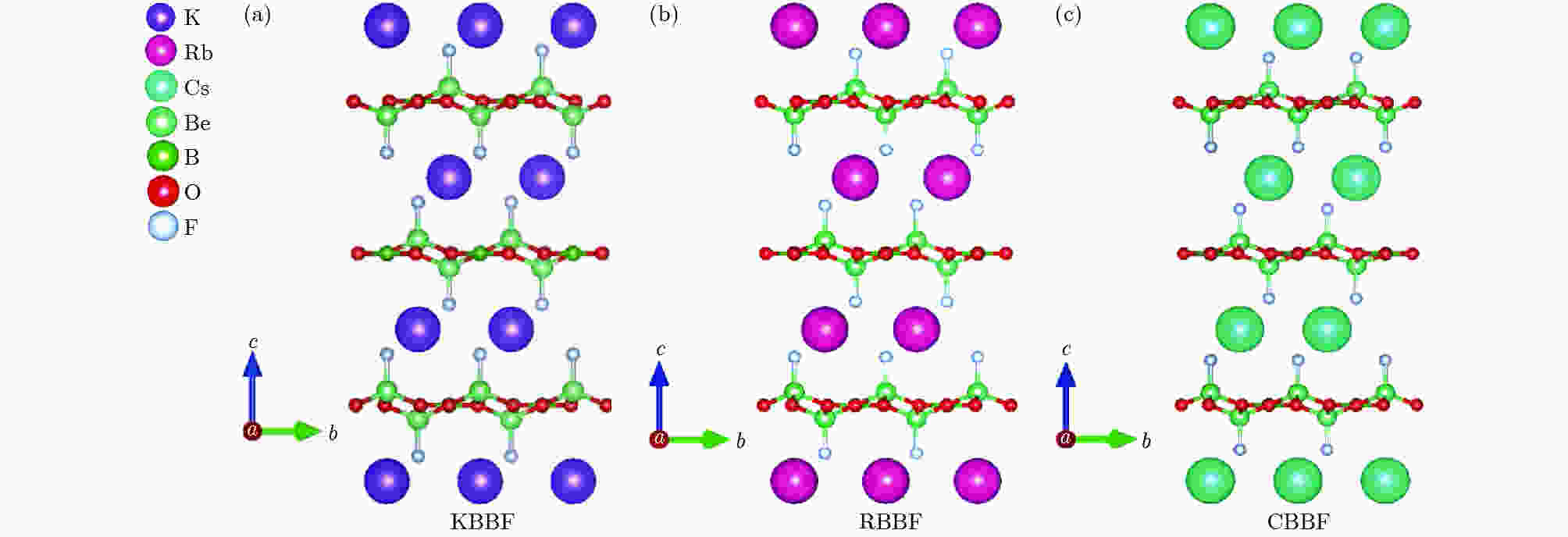
INVITED REVIEW
2019, 68 (2): 024208.
doi: 10.7498/aps.68.20182145
Abstract +
The use of nonlinear optical crystal materials to extend the limited range of laser sources to the deep-ultraviolet (deep-UV, λ < 200 nm) regions by various frequency conversion techniques, has become an attractive field for generating deep-UV light. However, the lack of nonlinear optics (NLO) crystal materials capable of frequency conversion in the deep-UV light range, limits the development and application of deep-UV all-solid-state lasers. Therefore, scientists all over the world are actively exploring the new generation of deep-UV NLO crystal materials. At present, only the KBe2BO3F2 (KBBF) crystal is capable of generating deep-UV light through the direct sixth harmonic generation of the Nd:YAG laser. The infinite ∞[Be2BO3F2]− single layers, as the brilliant building blocks in the crystal structures of KBBF family, provide a relatively large second harmonic generation coefficient (d11 = 0.47 pm/V) and a sufficient birefringence (Δn = 0.07@1064 nm). However, the KBBF crystals have insurmountable intrinsic defects, such as the usage of high toxic beryllium oxide, and the serious layer growth habit, which greatly restrict its commercialization process. Since the layered structure of the KBBF crystal is still one of the most brilliant structures for generating deep-UV laser, an effective strategy is to change the interlayer connection mode and develop new NLO materials based on KBBF with less layering growth habit. In this paper, by reviewing the development history of borate deep-UV NLO crystals and the derivatives of KBBF, the relationship between layered structure and optical properties of different interlaminar connections of crystal materials is systematically analyzed. We discuss the main contradictions and solutions of the development of deep-UV NLO crystal materials which are similar to the KBBF structure. In order to provide a reference for the innovative exploration of new materials in the future, several design strategies are also proposed.
GENERAL
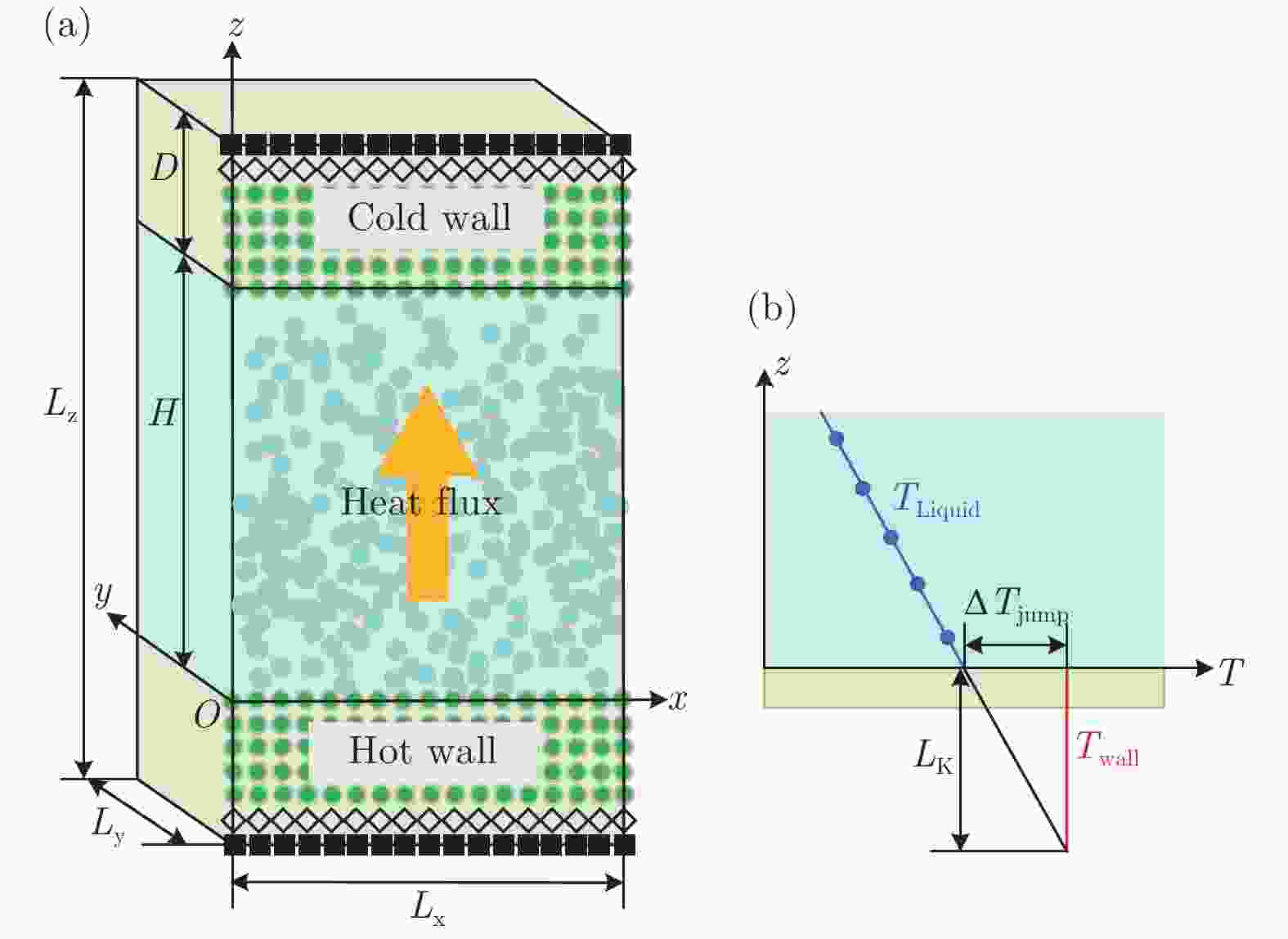
2019, 68 (2): 020201.
doi: 10.7498/aps.68.20181876
Abstract +
The heat transfer in microchannel has attracted considerable attention due to many important applications in biology, chemistry, physics and engineering. When the fluid size shrinks to nanoscale, the energy transport of micro-system is significantly different from the conventional case. It is of great significance to study the size effect on heat transfer in a micro-system. However, there is a large size gap between existing molecular dynamics simulation and experimental measurement, in which the size effect on solid-liquid interfacial thermal resistance is rarely involved. Non-equilibrium molecular dynamics simulation is performed to investigate the heat transfer through the solid-liquid interface. Simple Lennard-Jones (LJ) fluid is simulated as the ultra-thin liquid film in a non-equilibrium simulation system. The liquid film is confined in a nanochannel composed of two solid surfaces. The potential function between solid and liquid atom is represented by a modified LJ function to control the solid-liquid interfaces of different surface wettabilities. We examine the size effect on temperature jump and thermal resistance at the solid-liquid interface. The fluid number density and temperature distribution in the perpendicular direction of solid wall are evaluated. It is found that the liquid atoms near wall are arranged as a solid-like structure. Particularly in the small channel, liquid atoms confined in the channel are affected by two solid walls. However, with the increase of channel height, the liquid atoms in the middle channel move freely, leading to the decrease of the size effect. The simulation results show that the dependence of thermal resistance on microchannel height exhibits two regimes: (i) monotonically increasing dependence for the small channel and (ii) keeping constant thermal resistance for the large channel. These two distinct trends can be explained by phonon vibrational density of states (VDOS) of solid wall and liquid. For the small channel, a stronger confinement of liquid leads to a weaker mismatch in VDOS of solid wall and liquid, thus resulting in a smaller thermal resistance. Whereas, for the large channel, the vibrational coupling between the solid and the liquid atom remains unchanged and the size effect is negligible. The size thresholds of the two regimes of the thermal resistance are both sensitive to the liquid-solid interaction strength, which decreases with solid-liquid interaction increasing. Furthermore, with the increase of the microchannel height, the temperature jump at the solid-liquid interface monotonically decreases and eventually approaches to the non-jump temperature boundary on a macroscopic scale. These findings may help to understand the mechanism of temperature boundary conditions on a microscopic scale and a macroscopic scale and provide a theoretical support for manufacturing new nano-devices.

2019, 68 (2): 020501.
doi: 10.7498/aps.68.20180912
Abstract +
The aim of this study is to address the following issues: 1) revealing the typical behaviors and properties of pedestrian movement when going upstairs and downstairs; 2) constructing a pedestrian evacuation model to formulate the walking process of pedestrians in stair area; 3) verifying that the cell transmission model widely used in the two-dimensional walking space can also be applied to the three-dimensional staircase area. Firstly, an observation experiment is carried out to gain the pedestrian movement data in the process of going upstairs and downstairs. By collating the data, the relation between density and flow in the unidirectional process of going upstairs or going downstairs, and in the bi-directional process of going upstairs and downstairs, are drawn respectively. Then, by analyzing the fundamental diagrams, several characteristics of pedestrian movement in stair area are revealed. Based on these characteristics, an extended cell transmission model is proposed. In this model, a potential correction coefficient is introduced to change the route choice of pedestrians by using the influence of different directional pedestrians on the potential; a flow modification coefficient is introduced to describe the effect of physical parameters on the maximum flow at the boundary between two neighboring cells; and an offset coefficient is introduced to correct movement rules and strengthen the influence of preferential direction on pedestrian route choice. Further, simulations relied on the proposed model are conducted. By comparing the simulation results with the experimental data, the model is calibrated. Then the calibrated model is employed to formulate the pedestrian movement in stair area, and the sensitivity of the potential correction parameter is also discussed. The simulation results indicate that the proposed model can successfully reproduce the movement of pedestrians on stair. Moreover, the route-choice behaviors of pedestrians can be directed by varying the values of the potential correction coefficient, which can present important information about optimizing the evacuation process of pedestrians on stair, thereby reducing the risk of an accident, such as congesting and treading.
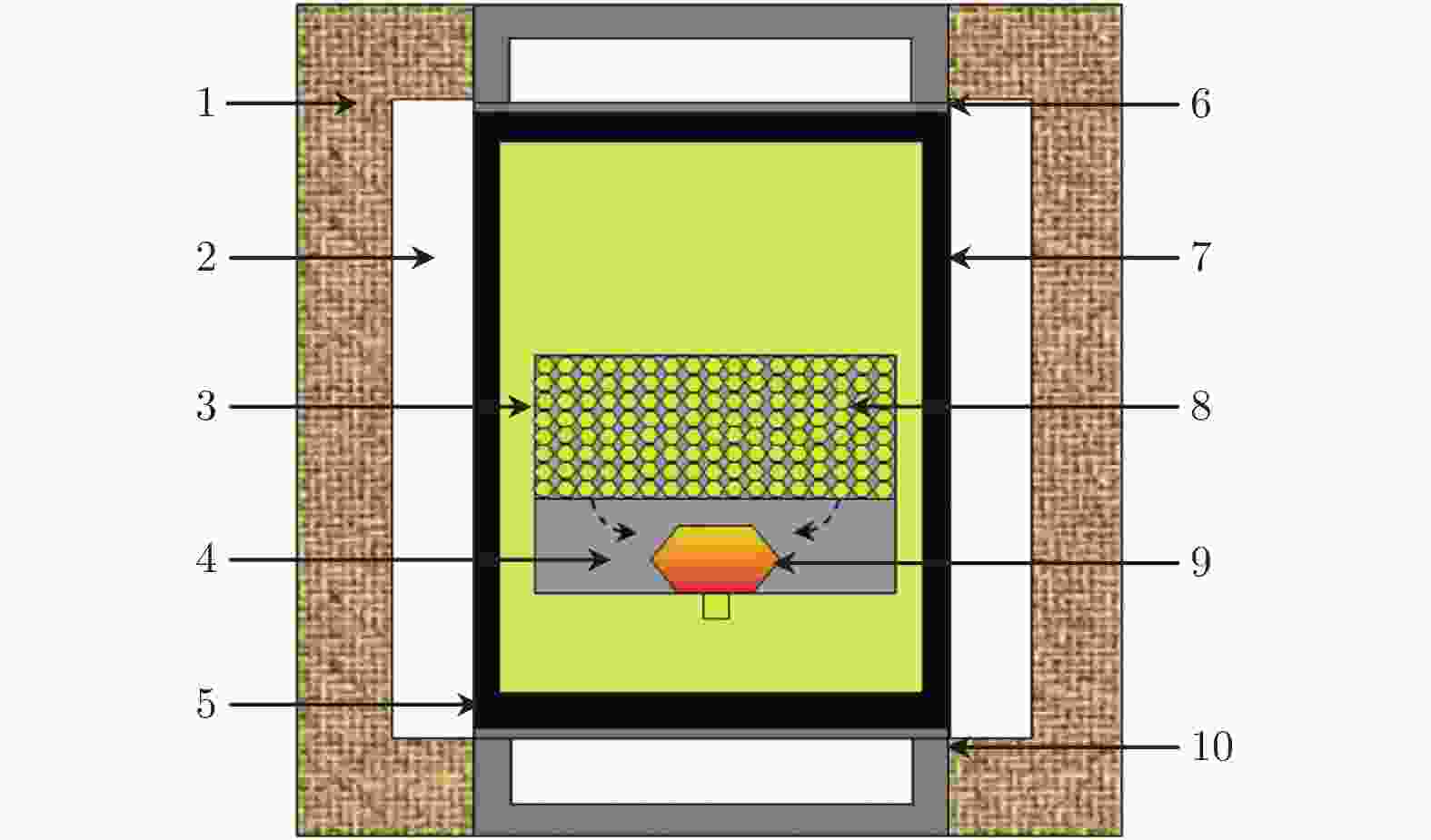
2019, 68 (2): 020701.
doi: 10.7498/aps.68.20181855
Abstract +
In the paper, under 5.6 GPa and 1250−1450 ℃, the Ib-ype diamond single crystals chosen as the seed crystals with different sizes, are synthesized in a cubic anvil at high pressure and high temperature. High-purity Fe-Ni-Co solvents are chosen as the catalysts. High-purity graphite powder (99.99%, purity) is selected as the carbon source. Hexahedral abrasive grade high-quality diamonds of 0.8 mm, 1.5 mm or 2.2 mm in diameter are chosen as seed crystals. The effects of seed crystal size on the growth of gem-diamond single crystal are studied in detail. Firstly, the influence of the change of seed size on the cracking of diamond single crystal is investigated. The crystal growth law of increasing the probability of cracking crystal with larger seed crystal is obtained. It can be attributed to the following two points. i) The residual cross section at the separation of the main crystal from the larger seed crystal is too large, thus reducing the overall compressive strength of the crystal. ii) The growth rate of the diamond crystal synthesized by larger seed crystal is too fast, which leads to the increase of impurities and defects and the decrease of compressive strength of the crystal. The decrease of crystal compressive strength leads to cracks in diamond crystals during cooling and depressurizing. Secondly, in the growth time of 25 hours, the relationships between the growth time and the limit growth rate of the diamond single crystals synthesized by choosing three sizes of seed crystals are investigated. The results show that the high-quality single crystal synthesis efficiency can be improved and the synthesis period can be shortened by selecting large seed crystals. This is because the size of the seed crystal becomes larger at each stage of crystal growth, resulting in the enhancement of the ability of diamond single crystal to receive carbon, so that high-quality diamond single crystals can be grown at a faster growth rate. Thirdly, with the help of scanning electron microscope or optical microscope, we calibrate the surface morphologies of diamond single crystals grown with different-size seed crystals. Using the seed crystals of 0.8 mm, 1.5 mm or 2.2 mm in diameter, high-quality diamond single crystals with smooth surfaces can be synthesized. However, with the increase of seed crystal in size, the surface flatness of the grown crystals tends to decrease and the possibility with which surface defects occur and string inclusions increase. The growth rate of high-quality diamond single crystals grown with larger seed crystals must be strictly controlled. Finally, the N impurity content values of diamond single crystals grown with different seed crystals in size are characterized by Fourier transform infrared measurement. The results show that the N impurity content of the crystal increases with the diamond growing rapidly by selecting larger seed crystal.

2019, 68 (2): 020301.
doi: 10.7498/aps.68.20181314
Abstract +
The photon-atom interface is a basic component of quantum repeater, quantum network, and linear optical quantum computing. Different approaches have been tested in the last decade to develop quantum interface, such as quantum dots, single atoms and ions, color centers and cold atomic ensemble. In the cold atomic ensemble, a normal way to produce photon-atom interface is the Duan-Lukin-Cirac-Zoller (DLCZ) protocol. Used in the DLCZ protocol is an atomic ensemble that can emit single photons while creating a single atomic excitation, which is stored in the ensemble. The atomic excitation can be converted into a photon due to the collective interference. The influences of the retrieval efficiency on the atom-photon entanglement source have been studied in various experiments. But no one has studied the retrieval efficiency threshold of entanglement generation. In our experiment we study the retrieval efficiency dependence on read power and OD. Setting the power of the repump light beam to be 12.2 mW, 5.0 mW, 2.0 mW, 0.5 mW and 0.3 mW, OD of the cold atom ensemble is measured to be 20, 17, 10, 2, and 1, respectively. As we expected, the retrieval efficiency increases with increasing OD value and read power, the curve shows that the retrieval efficiency increases sharply with increasing the OD value and read power, then after a while slowly increases with increasing the OD values and read power. Then we measure the Bell parameter with increasing the retrieval efficiency by increasing the read power. It shows that the Bell parameter sharply increases for retrieval efficiency values ranging from 0 to 3%, but changes very small for retrieval efficiency values ranging from 3% to 18.3%. The maximum Bell parameter is 2.6. We further analysis the result, finding that the Bell parameter can be expressed as $S = \dfrac{{{S_{{\rm{MAX}}}}r}}{{(1 + 2\chi )r + 2B}}$ . Fitting parameters to the curve are $\chi$ = 1%, B = 0.073%. To avoid of multi-excitation the write power kept low that $\chi$ at 1% level. Then we can find out from the function that the signal-to-noise ratio is bigger than 6∶1 the Bell parameter will reach 2. The theoretical analysis and experimental results fit very well. So the further reason that alter the Bell parameter is the signal-to-noise ratio. We should decrease the noise while increasing the retrieval efficiency. This paper will help with rise the quality of entanglement generation through photon-atom interface.

2019, 68 (2): 023102.
doi: 10.7498/aps.68.20181915
Abstract +
A systematical knowledge of the atomic properties in plasma is of great interest for various research areas, such as the explanation of the X-ray radiation from universe, plasma diagnostics, extreme ultraviolet (EUV) and X-ray sources and so on. Among these researches, the detailed information about how the plasma influences the atomic energy level and transition spectrum are crucial for understanding the X-ray emission mechanism and the state of plasma. An analytic calculation method of treating the non-relativistic energy and its relativistic corrections for the multi-electron atoms embedded in weakly coupled plasma is developed based on the Rayleigh-Ritz variation method. The systematical investigations are performed for the ground state 1s2 1S, single excited states 1sns 1,2S (n = 2−5), 1snp 1,3P (n = 2−5) and double excited state 2s2p 1P of Ar16+ ion in weak coupled plasma. The analytic formulas for calculating the non-relativistic energy and its relativistic correction energy are derived, which include mass correction, one and two-body Darwin correction, spin-spin contact interaction and orbit-orbit interaction. All the angular integration spin sums involved in the problem are worked out explicitly by using the irreducible theory. The influence of plasma on non-relativistic energy and relativistic correction energy are discussed. The results show that the mass correction and the one-body Darwin correction are the main ones among the terms of relativistic correction, and are three orders of magnitude greater than the other relativistic terms. The plasma shielding effect mainly affects the non-relativistic energy, and has little effect on the relativistic correction. At the same time, it has a more significant selectivity for the electronic configuration. Further research shows that the influence of plasma on the energy of the outer shell electron is greater than that of the inner shell electron. With the increase of the plasma shielding parameters, the outer shell electron extends outward, and the higher the excited state, the greater the degree of extension is. This work should be useful for astrophysical applications where such a plasma environment exists.
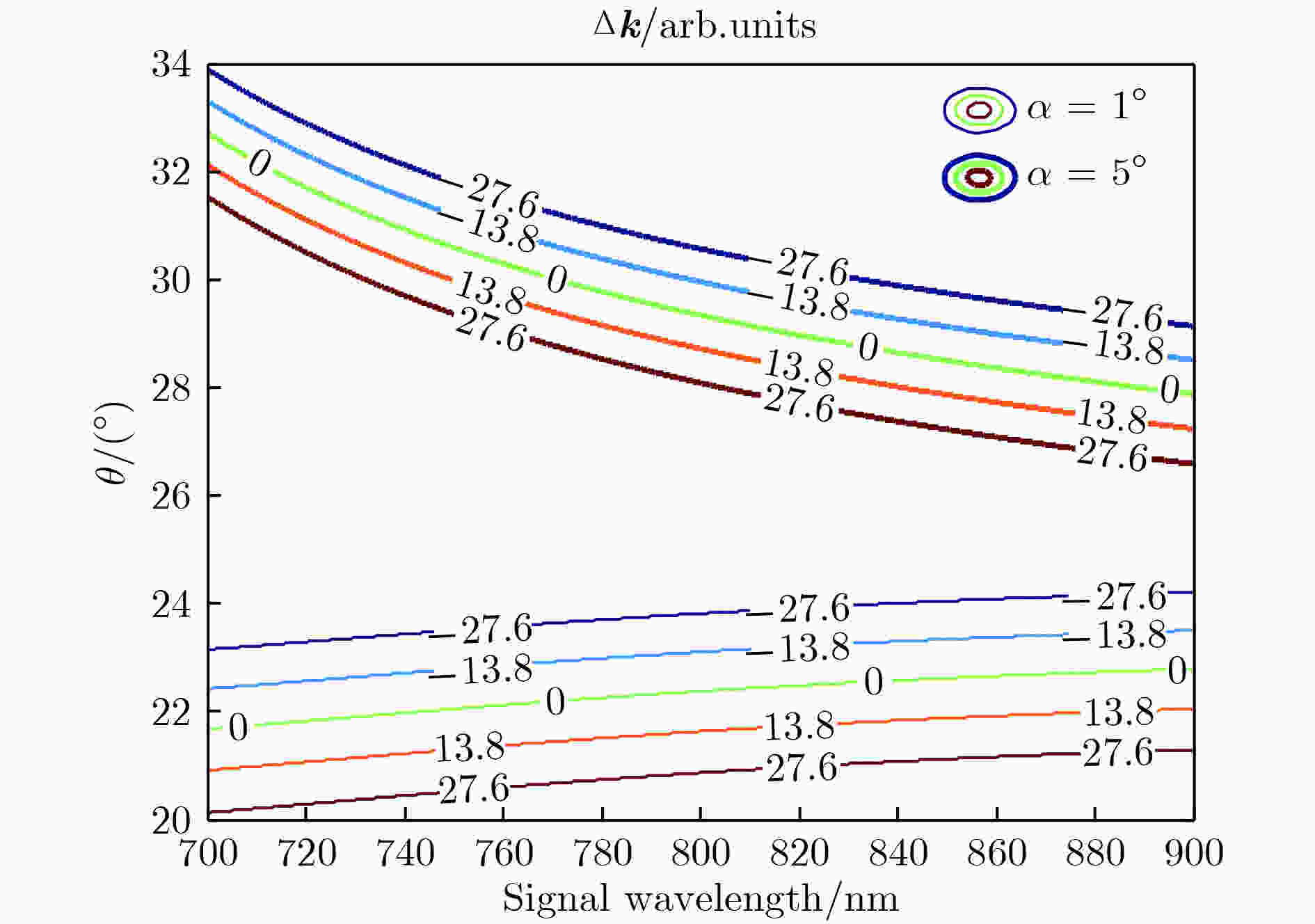
2019, 68 (2): 024205.
doi: 10.7498/aps.68.20181538
Abstract +
One of the goals pursued in laser pulse is to achieve a laser with a shorter duration and higher intensity. In the past two decades, the laser pulse duration has been shortened by more than 7 orders of magnitude due to the development of Q-switched, Mode-locked and pulse compression technology. The peak power of laser pulse has been increased to PW, even EW and ZW from initial MW with the development of pulse amplification technology, whose focused intensity can reach to 1023 W/cm2. Thus, it provides unprecedented extreme conditions, and speeds up the laser applications in ultrafast nonlinear optics, strong field physics, fast ignition of laser nuclear fusion, optic communication, etc. The optical parametric chirped pulse amplification (OPCPA) is one of the important technologies in ultra-short laser pulse field. It is of great significance to increase the gain bandwidth for improving the conversion efficiency of OPCPA and achieving broadband optical parametric amplification. Combining the optical beam deflection and non-collinear OPCPA, a novel scanning broadband OPCPA model is proposed based on the optical beam deflection. The basic principle of increasing the gain bandwidth for the scanning broadband OPCPA is analyzed theoretically, which ensures the phase matching of each frequency component of signal by optical beam deflecting to change the non-collinear angle constantly. Namely, the non-collinear angles of incident frequency components of signal are different from each other, which, however, makes the whole phase matching of signal, i.e. momentum conservation in optics. The optical parametric amplification of signal pulse with 800 nm central wavelength and almost 100 nm bandwidth is simulated numerically by the proposed scanning broadband OPCPA. The results show that the bandwidth after being amplified is almost the same as before and there is no spectral narrowing, and the scanning broadband OPCPA increases the gain bandwidth and conversion efficiency greatly compared with the amplification with a constant given non-collinear angle, which leads to broadband optical parametric amplification. Finally, it is necessary to make sure that the on-load voltage to the KTN crystal matches with the frequency of signal pulse in time and reduces the unfavorable voltage deviation and time-delay for the maximizing gain bandwidth and conversion efficiency and ensuring the phase matching of each signal frequency component. The results of this paper not only provide an approach to increasing the gain bandwidth of OPCPA, but also supply some theoretical references and the basis for the experimental work of OPCPA in ultra-short laser pulse system.
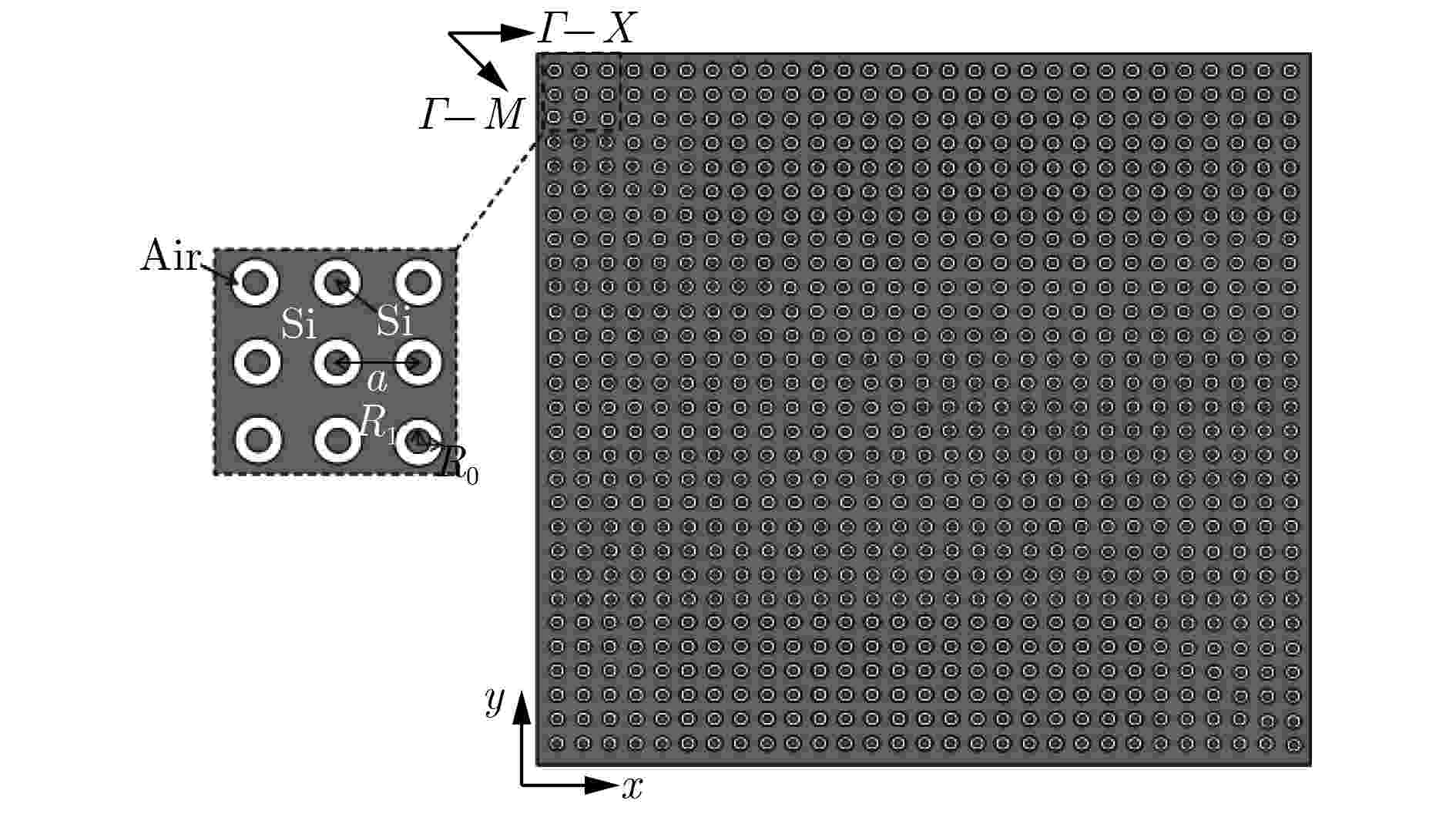
2019, 68 (2): 024206.
doi: 10.7498/aps.68.20181397
Abstract +
Optical diode is a device that can realize unidirectional transmission of light. Its function is similar to that of an electronic diode. It has important applications in the field of optoelectronic integration and all-optical communications. Unidirectional wave transmission requires either time-reversal or spatial inversion symmetry breaking. The magneto-optical effect and optical nonlinearity are usually utilized to break the time-reversal symmetry and obtain the unidirectional transmission. However, these schemes all need high light intensity or magnetic field strength to be realized, and limit the usage. Therefore, spatial inversion symmetry breaking is highly desirable because of totally linear materials under low intensities. Quit a lot of researchers have designed optical diodes based on the photonic crystals and achieved unidirectional transmission for TE-like or TM-like light. The early design realized light unidirectional transmission by PC structures for only one polarization state (TE-like or TM-like incident light). It limits the application for the high integration and reconfigurable optical interconnection. The structure which can achieve unidirectional transmission for both TE and TM polarizations needs to be designed. The annular PCs have been verified to realize polarization-independent phenomena, such as beam splitting, self collimation and waveguide. In this paper, an annular PC is proposed. The plane wave expansion method is used to calculate band structures. The results show that it exhibits a significant directional band gap for both TE and TM mode. Then, the triangular annular PC is constructed, and its transmission spectra and field distributions are calculated by the finite-different time-domain method. It is found that the structure can realize the polarization-independent unidirectional transmission, but the forward transmissivity is too low (about 20%). Moreover, another smaller size annular PC is further introduced to form annular PC heterojunction, which effectively improves the polarization-independent unidirectional transmission performance and the forward transmissivity has doubled. Through the adjustment of the interface structure, the forward transmissivity is further increased. The optimized annular PC heterostructure can realize polarization-independent unidirectional transmission, and the forward transmissivity reaches 44%. The heterostructure can be used to fabricate polarization-independent optical diode, and may have potential applications in complex all-optical integrated circuits.

2019, 68 (2): 024207.
doi: 10.7498/aps.68.20181361
Abstract +
The illumination uniformity of laser beams in inertial confinement fusion (ICF) facility is a key factor, which plays a crucial role in suppressing the laser plasma instabilities. However, the prevailing beam smoothing techniques cannot meet all the requirements for improving the irradiance uniformity of laser beams and mitigating the laser plasma instabilities, which are determined by the high-frequency spatial modulations and the fine-scale speckles of the focal spots. An ultrafast azimuthal beam smoothing scheme based on vortex beams is proposed in this paper. In this scheme, two of the four beams in a laser quad are transformed from super-Gaussian (SG) beams into vortex beams by inserting two spiral phase plates with opposite topological charges into the beam path, whereas the other two SG beams remain unchanged. By controlling the polarization and the center wavelength of each beam, the SG beam and the transformed vortex beam in the quad are coherently superposed on the target plane, so are the remaining two beams. Owing to the difference in central wavelength and the existence of the topological charges, two focal spots rotating in a period of a few picoseconds are generated in the target plane, which can redistribute the speckles quickly in temporal domain and thus improve the irradiance uniformity of the laser quad. By establishing the physical model of the azimuthal smoothing scheme, the smoothing characteristics including the rotation period, the illumination uniformity and the fractional-power-above-intensity of the focal spots are analyzed in detail. In order to improve the smoothing characteristics significantly, the novel smoothing scheme is further combined with another ultrafast smoothing scheme, i.e. radial smoothing scheme. The influence of the key parameters of the combined smoothing scheme on the illumination uniformity and on the smoothing velocity are discussed. Results indicate that the azimuthal smoothing scheme can achieve the ultrafast smooth of the laser quad in the azimuthal direction and the best illumination uniformity within a few picoseconds as well. Though the degree of improvement in the irradiance uniformity of the azimuthal smoothing scheme is lower than that of the radial smoothing, the combination of these two schemes can improve the uniformity effectively and rapidly. The novel smoothing scheme provides a potential smoothing approach for the high-power laser facilities.
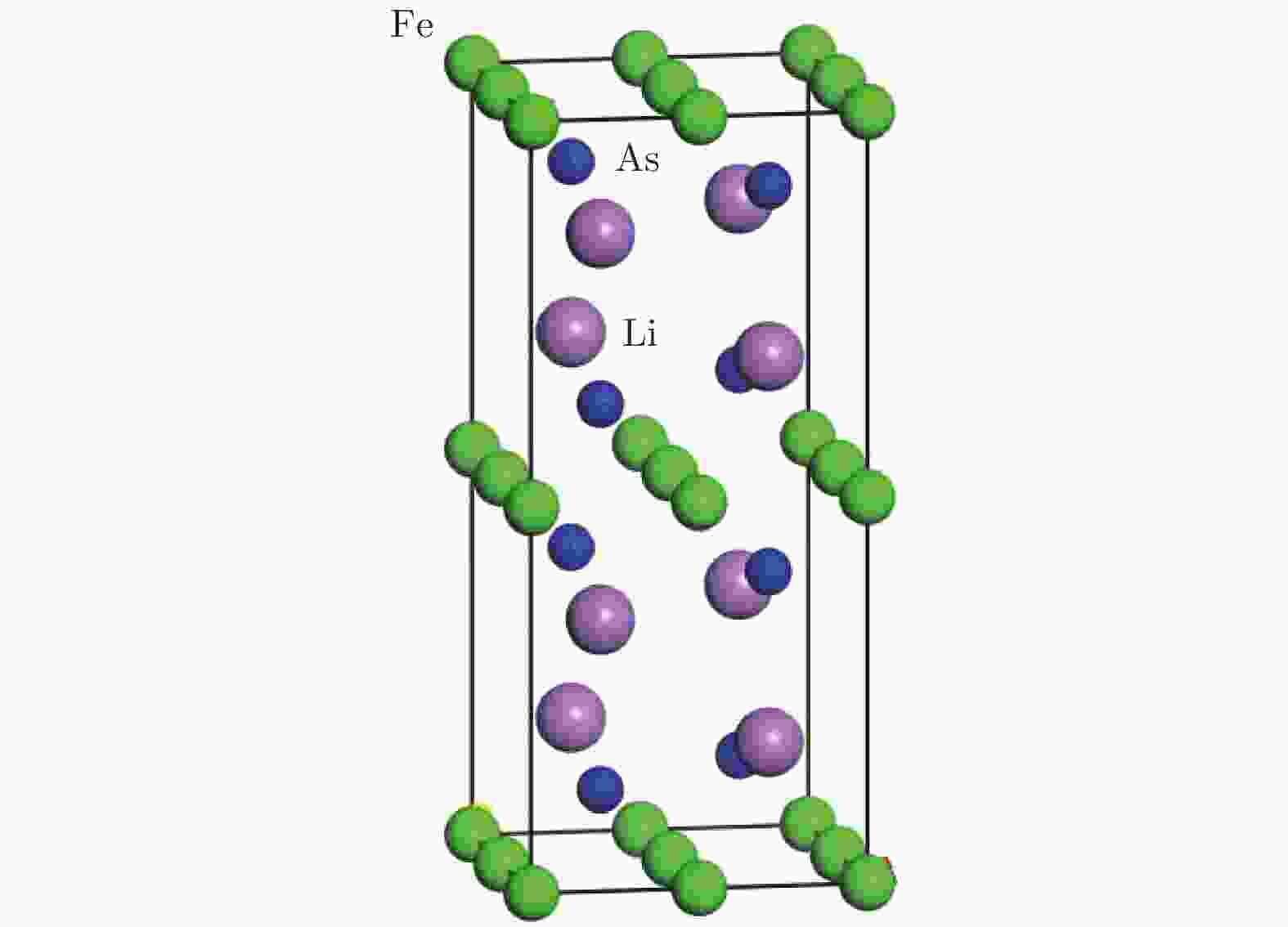
2019, 68 (2): 027401.
doi: 10.7498/aps.68.20180957
Abstract +
The magnetism, band properties and electronic density of states of LiFeAs superconducting thin film with two-dimensional strain are investigated by using the first principles calculations based on density functional theory, and the influences of different strains on the characteristics of superconducting films are analyzed in detail. The results show that the magnetic ground configuration is the striped antiferromagnetic state of nostrained LiFeAs thin film, and the ground structure of this system is unchanged in the range of applied 1%−6% compressive and tensile strain. The density of states near the Fermi level is mainly from the contribution of Fe-3d orbital and a few As-4p electrons. The electron spin exchange coupling between Fe ions is realized by As ions. Furthermore, unlike the case of the nostrain and the tensile strain, with increasing the compressive strain, the localized antiparallel electron spin magnetic moments of Fe ion decrease, the density of states at the Fermi surface improves, and the itinerant electron magnetism of Fe ions increases, which all greatly suppress the antiferromagnetic properties of thin film and enhance the superconducting phase transition temperature. The superconductivity of LiFeAs thin film originates from the Cooper pairs of electrons between the hole-type and electronic-type bands near the Fermi surface through the antiferromagnetic superexchange coupling effect. Instead, the LiFeAs thin film with the tensile strain presents completely opposite properties, that is to say, the decrease of the electronic density of states in the Fermi level brings about the weakening of the metal properties and the increasing of the antiferromagnetic exchange coupling. Particularly, the band structure of hole-type near the Fermi surface disappears, and the occurrence of Cooper pairs of electrons becomes significantly reduced, resulting in the suppressed superconducting phase transition when the LiFeAs thin film is subjected to tensile strain. In addition, the change of antiferromagnetic exchange coupling and magnetic moments of Fe ions are also explained according to the variation of electronic density of states of the Fe-3d energy levels during the distortion of FeAs tetrahedrons due to compressive strain. In brief, our researches provide an effective way to improve the superconducting properties of LiFeAs thin film and may promote the relevant practical applications of iron-based superconductors in the future.

2019, 68 (2): 028101.
doi: 10.7498/aps.68.20181759
Abstract +
Recently, the monolithic spin-coating perovskite/planar silicon heterojunction tandem solar cells with high performance have attracted attention mainly due to simple fabrication, low preparation cost and high efficiency, especially compared with fully textured multi-junction perovskite/silicon tandem device. As is well known, the excellent passivation of a-Si:H/c-Si interface is the key to achieving a high-efficiency planar silicon heterojunction solar cell, which further improves the performance of the corresponding tandem cell. Therefore, we investigate the elements affecting a-Si:H/c-Si interface passivation, including the c-Si surface treatment technique, a-Si:H passivation layer and P-type emitter layer and so on. In these experiments, we adjust the immersed time of diluent hydrofluoric acid and pre-deposited hydrogen plasma with different gas mixture flows. Also, the suitable deposition parameters of intrinsic a-Si:H passivation layer are regulated by varying hydrogen dilution and time, and variously slight silane content is embedded into i-a-Si:H /P-type (I/P) emitter interface by hydrogen-rich plasma treating which is for acquiring optimal experimental processing conditions to promote the chemical passivation. In addition, the p-a-Si:H and p-nc-Si:H are comparatively studied as buffer layers to further improve the I/P interface passivation by varying the hydrogen dilution in the gas mixture during deposition. It can be found that p-nc-Si:H buffer layer with high conductivity and wide bandgap can not only reduce the defect density at the I/P interface, but also increase the conductivity of P-type emitter, which further improves the field passivation effect. By the above- mentioned optimization, the highest minority carrier lifetime and implied open-circuit voltage (iVoc) of the structure of P-type emitter/a-Si:H(i)/c-Si/a-Si:H(i)/N-type layer (inip) sample can respectively reach 2855 μs and 709 mV, which demonstrates authentically outstanding passivation performance. An efficiency of 18.76% can be obtained for the planar a-Si/c-Si heterojunction solar cell with a Voc of 681.5 mV, which is 34.3 mV higher than that of the reference device. Regarding the optimized planar a-Si:H/c-Si heterojunction solar cell as the bottom cell, we also obtain an efficiency of 21.24% for perovskite/silicon heterojunction tandem solar cell with an open-circuit voltage of 1780 mV, which proves that the above strategies are very effective for improving the passivation optimization and performance of bottom cell in the tandem device.

2019, 68 (2): 028702.
doi: 10.7498/aps.68.20181772
Abstract +
It is an important practical problem to accurately recognize whether biological tissue is denatured during high intensity focused ultrasound (HIFU) treatment. Ultrasonic scattering echo signals are related to some physical properties of biological tissues. According to the characteristics of ultrasonic scattering echo signals, the recognition of denatured biological tissues is studied based on the variational mode decomposition (VMD) and multi-scale permutation entropy (MPE) in this paper. The ultrasonic echo signals are decomposed into various modal components by the VMD. The noise components and the useful components are separated according to the power spectrum information entropy of various modal components. The separated useful signals are reconstructed and the MPE are extracted. Furthermore, Gustafson-Kessel (GK) fuzzy clustering analysis is employed to obtain the standard clustering center, and the recognition of denatured biological tissues is carried out by Euclid approach degree and principle of proximity. The proposed method is applied to ultrasonic scattering echo signal during HIFU treatment. In order to determine the parameters of MPE algorithm for ultrasonic scattering echo signals, the embedding dimension of the MPE is discussed, and the scale factor of the MPE algorithm is optimized by genetic algorithm. When the delay time and the embedding dimension are 2 and 7 respectively, the MPE values decrease with scale factor increasing. Assuming that the scale factor is 12 from optimization results, the 293 ultrasonic scattering echo signals from normal tissues and denatured tissues are analyzed by the MPE. It is found that the MPE values of the denatured tissues are higher than those of the normal tissues. The MPE can be used to distinguish normal tissues and denatured tissues. Comparing with the recognition methods of the EMD-MPE-GK fuzzy clustering method and the VMD-WE-GK fuzzy clustering, the proposed method has good clustering performance and separability. Its partition coefficient (PC) is close to 1 and the Xie-Beni (XB) index is smaller. There are fewer feature points in the overlap region between MPE features of denatured tissues and normal tissues. The recognition results of denatured biological tissues in this experimental environment show that the recognition rate based on this method is higher, reaching up to 93.81%.
THE PHYSICS OF ELEMENTARY PARTICLES AND FIELDS
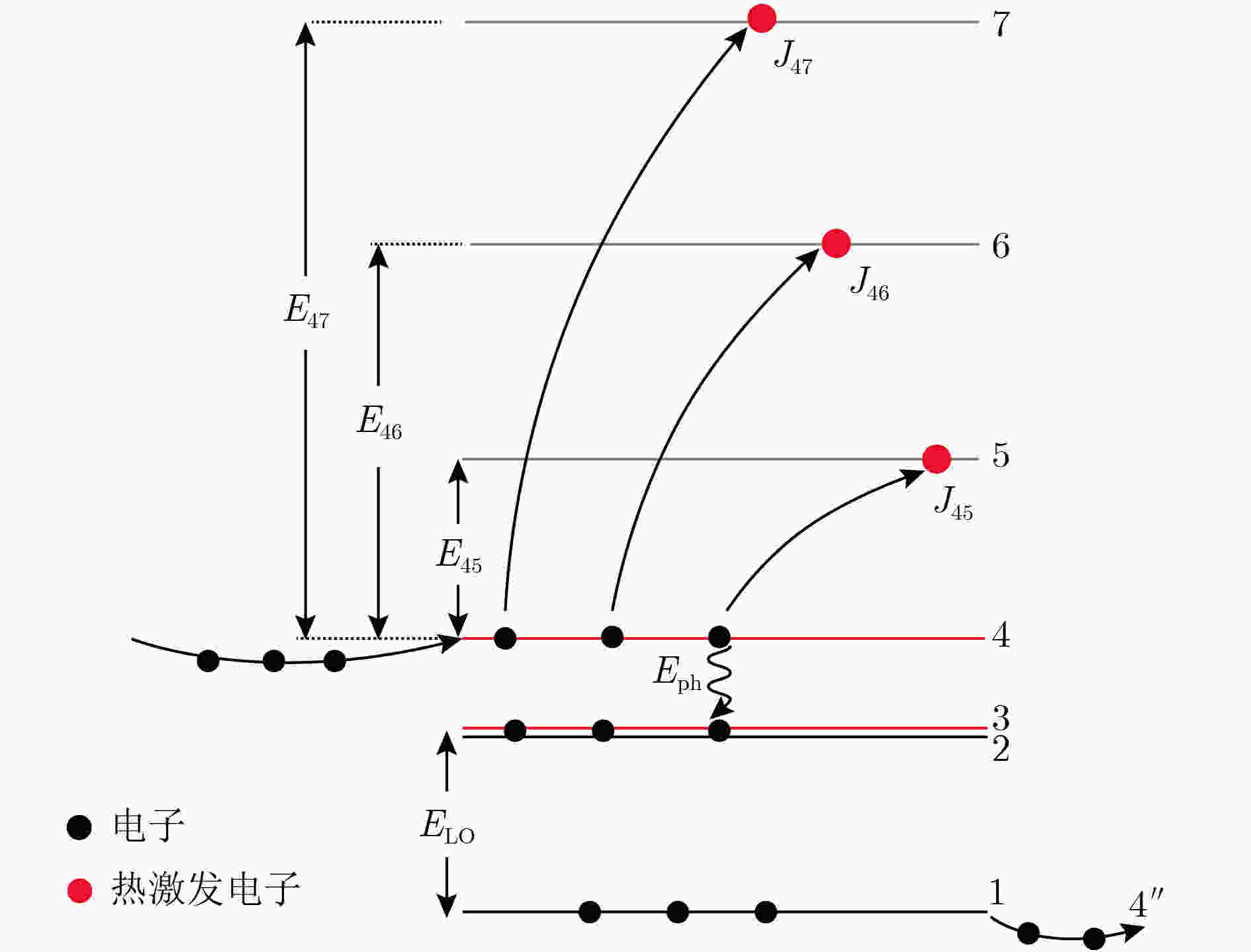
2019, 68 (2): 021101.
doi: 10.7498/aps.68.20181882
Abstract +
Terahertz quantum cascade laser is a semiconductor laser that effectively obtains terahertz waves. It uses the semiconductor heterojunction to have a quantum cascade effect under an applied voltage, and then the phonon assists the electron resonance from the upper stage to the next stage, so that a single electron injected externally can emit multiple photons. However, some electrons will deviate from the transport path during transportation and these electrons are called leakage electrons. Electron leakage comes from three ways. The first way is the scattering of electrons from the upper laser level through the long longitudinal phonon to the low energy level; the second way is the scattering of electrons from the lower laser level to the high energy bound level and the continuous level; and the third way is the scattering of electrons from the upper laser level to high energy bound levels and continuous levels. These leakage electrons directly reduce the number of population inversions in the laser system, making the laser output power limited. At present, most of researchers explain the electron leakage through indirect measurements, and there are few studies in which the electron leakage is analyzed by establishing theoretical models. In this paper, the electron leakage model in THz QCL is established by using thermodynamic statistical theory and laser output characteristic theory. The degree of electron leakage is measured by output power. The influence of lattice temperature and quantum well barrier height on electron leakage are studied. It is found that when the lattice temperature rises and the electrons in the upper laser state leak to higher energy levels, the number of electrons leaking to the adjacent bound state and the continuous state increases, and the number of electrons leaking to the next near-bound level is relatively small. In the case of electron leakage, the utilization of electrons becomes lowered, and the laser output power is also lowered. The study also shows that an appropriate increase in the height of the quantum barrier can suppress the leakage of electrons. Using the established theoretical model to optimize the quantum well barrier height of the previously reported laser system, an 8 mW terahertz quantum cascade laser (THz QCL) laser output at 210 K is obtained. Compared with the reported experimental results, the temperature and output power are improved. These results provide a theoretical basis for studying the electron leakage temperature characteristics of THz QCL and also optimally designing the THz QCL active region structure.
NUCLEAR PHYSICS

2019, 68 (2): 022901.
doi: 10.7498/aps.68.20181613
Abstract +
In the study of the gas detectors, it is an important calibration method to use the ultraviolet (UV) laser with two-photon ionization mechanism for producing ionized signal. In the last decades, micro pattern gas detector, especially gaseous electron multiplier and micromesh gaseous detector, has been widely used in high energy experiments. These kinds of gaseous detectors have the advantages of higher ion backflow suppression ability, smaller E × B effect and good radiation resistance under the relatively higher count rate environment. To obtain a higher spatial resolution with a UV laser calibration system in gaseous electron multiplier detector, two critical technical issues remain to be resolved: the measurability of the laser signal and the accuracy of the laser beam position. In this paper, the studies in simulation and experiment are conducted to discuss these two critical questions. In the simulation section, the simulation results provide an estimation of signal in the gaseous electron multiplier detector with UV laser of 266 nm wavelength in the mixture working gases of Ar/CO2 (70/30), and give an evaluation of the laser pointing accuracy and the possible relative error of the electron drift velocity. In the experiment section, a UV laser calibration prototype is designed and developed. A pulsed laser of 266 nm wavelength is used as a signal source, which has a Gaussian-like cross section with a frequency of 10 Hz. The experimental results indicate that the signal of the UV laser in a triple gaseous electron multiplier detector reaches 400 mV for a readout strip width of 6 mm, a gain of detector of 5000, and a gain of amplifier of 10 mV/fC. For the calibration laser, the angle accuracy is discussed and tested. The angle uncertainty of the laser can be kept under 5′, and the accuracy of the drift velocity can reach 6.4 × 10−4 with a shift of 0.33 mm in the z direction when the laser beam transmits a distance of 400 mm in the gas chamber. All of these results show that the laser beam specific parameters are the main reference for designing the prototype detector. According to the optimal parameters, a gaseous prototype detector will be tested in the next study.
ATOMIC AND MOLECULAR PHYSICS
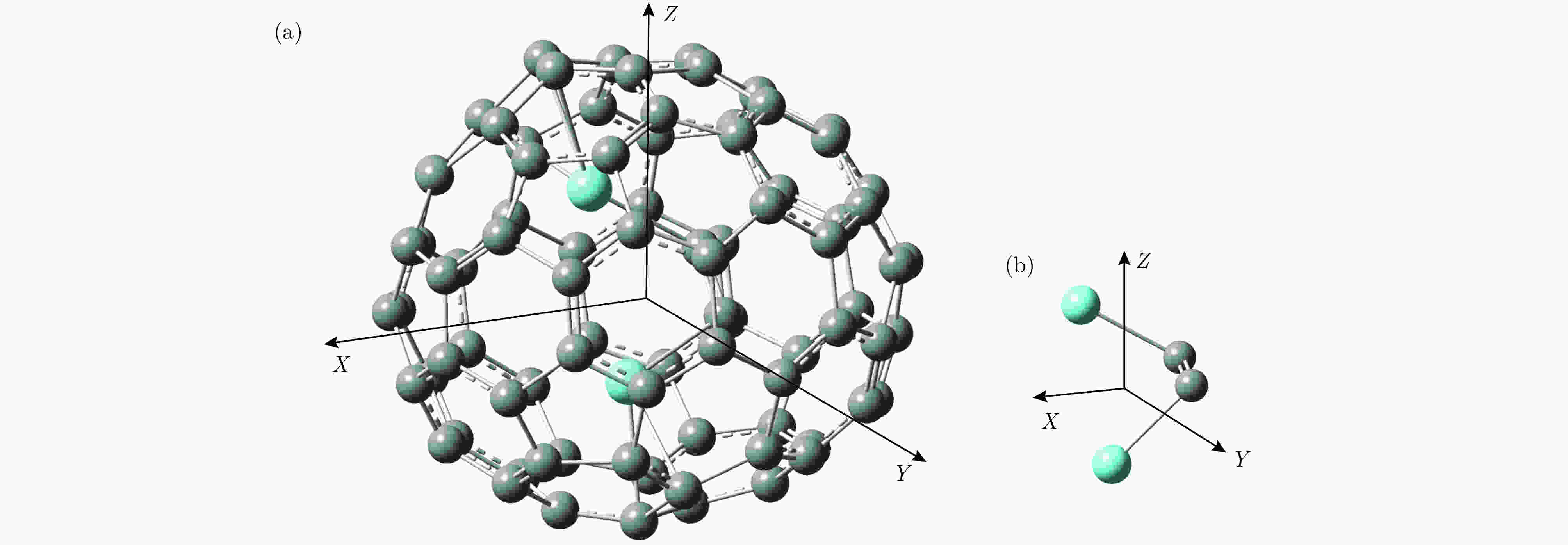
2019, 68 (2): 023101.
doi: 10.7498/aps.68.20181887
Abstract +
Spin switching and spin transfer are essential prerequisites for designing the spin-logic devices based on endohedral fullerenes. In this paper by combining the theoreticalΛ-process model with a self-designed genetic algorithm, we are able to theoretically observe spin-switching and spin-transfer scenarios on the subpicosecond time scale in the endohedral fullerene Y2C2@C82-C2(1) from first principles. The results show that the geometry of the optimized enclosed Y2C2 cluster is consistent with the experimental data. There exists a certain repulsive force between the external C82-C2(1) cage and the encaged cluster. However, the whole system still maintains its integral cage structure due to the excellent stability of the fullerene. In the Y2C2@C82-C2(1) system, it is found that the spin density is highly localized on the two Y atoms and only minimally distributed on the carbon cage. By analyzing the spin-density distribution and the evolution of the spin expectation values as influenced by the laser pulses, it is found that global spin switching can be achieved on the two Y atoms, while spin transfer between the two Y atoms actually results from the redistribution of the spin density among the two magnetic centers and the carbon cage under the action of the optimized laser pulses. The achieved spin-switching scenario completes within about 1000 fs and its fidelity reaches 97.8%, while the obtained spin-transfer process completes within 200 fs and its fidelity reaches 95.1%. The electron absorption spectra of the system verify that optical transitions are possible between the main intermediate states and the initial and final states involved in the spin-switching and spin-transfer scenarios. Therefore, by analyzing the electron absorption spectra corresponding to the initial and final states, the energy of the laser pulses adopted for the studied spin-dynamics process can be predicted, and the spin transferability can be evaluated. In addition, it is found that the smaller the detuning between the required energy difference and the applied laser pulse energy is, the greater the probability for spin switching/transfer scenarios becomes. The present results reveal the mechanisms of the laser-induced ultrafast spin dynamics in Y2C2@C82-C2(1) and can provide a theoretical basis for designing the spin-logic devices on realistic endohedral fullerenes.
ELECTROMAGNETISM, OPTICS, ACOUSTICS, HEAT TRANSFER, CLASSICAL MECHANICS, AND FLUID DYNAMICS
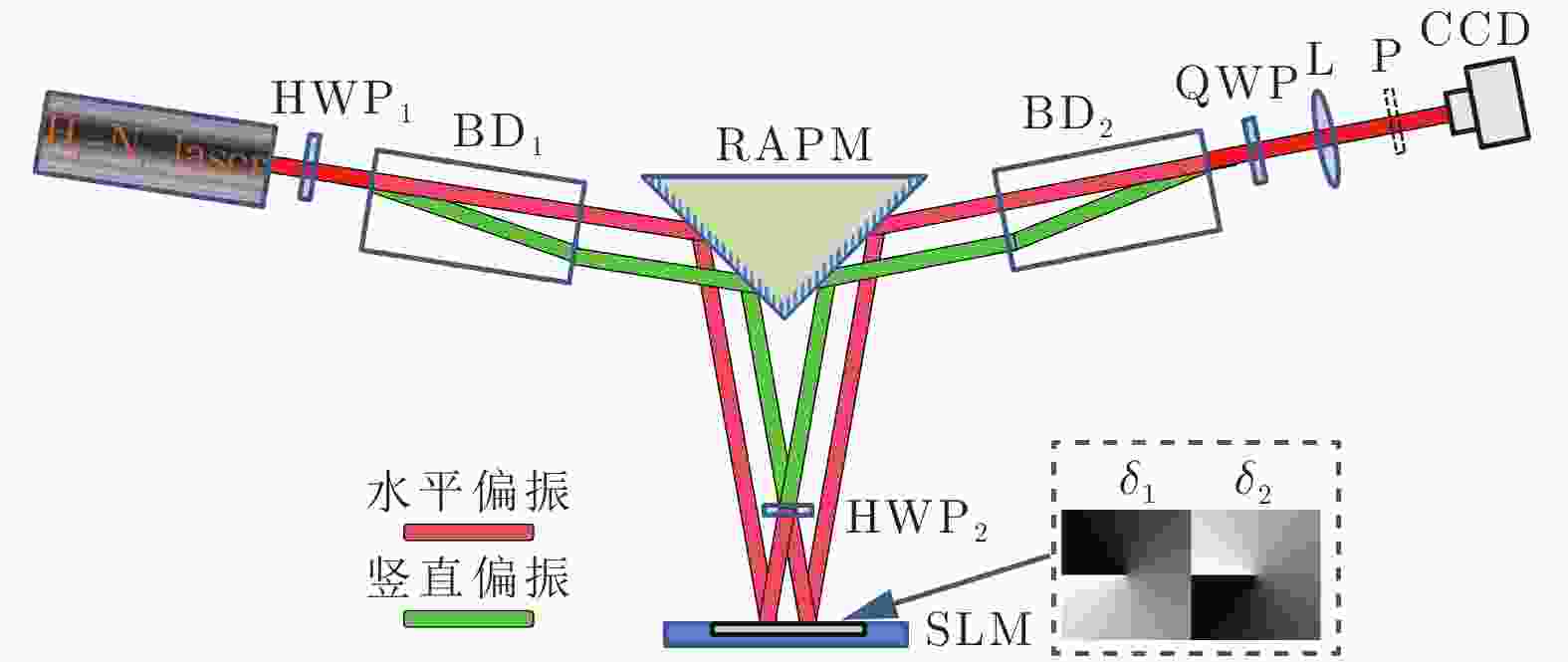
COVER ARTICLE
2019, 68 (2): 024201.
doi: 10.7498/aps.68.20181816
Abstract +
Vector beams have been used in scientific and engineering researches due to their unique focusing properties. In recent years, many methods of generating the vector beams have been proposed, among which the spatial light modulator (SLM) is widely used based on the superposition principle with using orthogonally polarized beams. However, the energy waste is generally associated with these superposition methods. How to efficiently generate vector beams is still a hot topic. Recently, we proposed an efficient method to generate tunable vector beams by using two triangular common-path interferometers (TCPIs) as the beam splitting and combining system. However, due to the complex structure of the TCPI, the system is difficult to adjust and unstable. In addition, the optical system brings about a long optical path, and the vector beams consisting of non-eigen modes will be distorted obviously with a long distance propagation. In this paper, an improved method is proposed. We replace the TCPIs with a pair of beam displacers, which act as a beam splitter and combiner, respectively. In this setup, we can arbitrarily manipulate the polarization states and phase distributions of vector beams in real time by managing the phase diagrams load on the SLM. The whole optical system does not involve any diffractive optical elements, and has a higher conversion efficiency. The improved optical system is compact and stable, and makes the adjustment of coaxiality easier. The light energy utilization depends mainly on the reflectivity of SLM. The efficiency of generating vector beams is increased to 58% by using an SLM with a reflectivity value of 79%. Several typical vector beams with phases and tunable amplitude, including cylindrical vector beams, fractional vector beams, and vector beams with double singularities, double-mode, radially variant polarization distribution, and azimuthally and radially variant polarization distribution, are generated and verified well experimentally. This method is also expected to create high-power vector beams and play an important role in laser processing and light trapping.
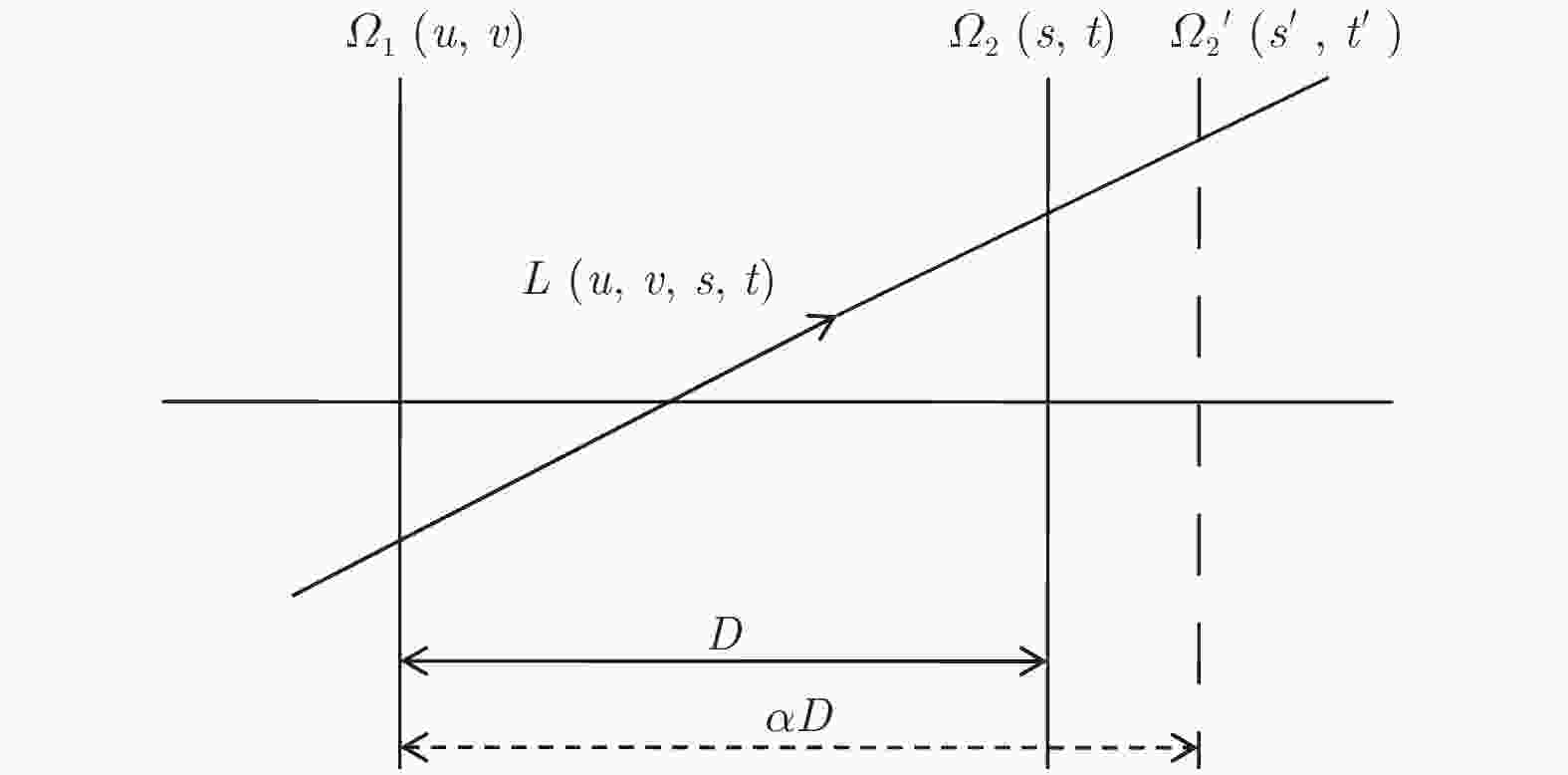
2019, 68 (2): 024202.
doi: 10.7498/aps.68.20181555
Abstract +
X-ray three-dimensional (3D) imaging technology is a research hotspot in the field of X-ray imaging. However, for some special imaging targets, the imaging mode of the traditional computer tomography (CT) circular trajectory is prone to lack of projection information, and thus affects the quality of CT reconstruction images, which limites the application of CT imaging. Light field imaging technology, in which a microlens array is inserted between the sensor and main lens in a traditional camera, achieves four-dimensional (4D) light field data with sensor during imaging including both the two-dimensional (2D) directional information of the radiance propagation and 2D spatial distribution information of object radiation. Through computer calculation imaging, 3D imaging such as digital refocusing, slice in the depth direction, stereo imaging, and depth estimation is realized. This article focuses on the 3D X-ray imaging based on the theory of light field imaging in visible light. Based on the model of parallel X-ray of synchrotron radiation source, the data of the X-ray light field with many projection views are acquired by rotating the image sample. Then, the light passing through any voxel in the imaging target is acquired by a geometric projection method, and based on integral imaging theory of light field imaging, the gray value of the slice in depth dimension is reconstructed and the depth information of reconstructed target is acquired. The reconstruction results show that this method can be used to reconstruct the internal slices at any depth in any viewing direction of the imaging target. In the optical imaging, the scene beyond the depth of field is blurred, making the scene more prominent and the imaging effect better. However, for the X-ray imaging, the imaging mode that is completely transmissive, and the light passing through the foreground carry the information about the background. In the refocusing process, the object at the refocusing depth is focused, and other background information is defocused. Excessive background information overwhelms the real useful information, and makes the slice, especially the edge of the image, blurred. Consequently more severe background noise is introduced due to the defocusing phenomenon in the optical refocusing process. Referring to the reconstruction method of the X-ray 3D imaging and light field imaging, the S-L filter is applied to the original data in the article. After filtering the original data, the X-ray "light field refocusing" is processed. The reconstruction results shown that the method can effectively eliminate reconstruction artifacts and improve image reconstruction quality in the reconstruction depth slice. And in this paper, the light field data are collected by rotating the sample with low time resolution. For the fast imaging, according to the digital refocusing theory of the light field imaging, the array X-ray source and detector can be used. After being calibrated, the system can realize the 3D reconstruction of the light field of the target field with high time resolution. This research has not only the theoretical significance in algorithm, but also great application value in the rapid detection of more complicated targets such as industry and medical treatment.
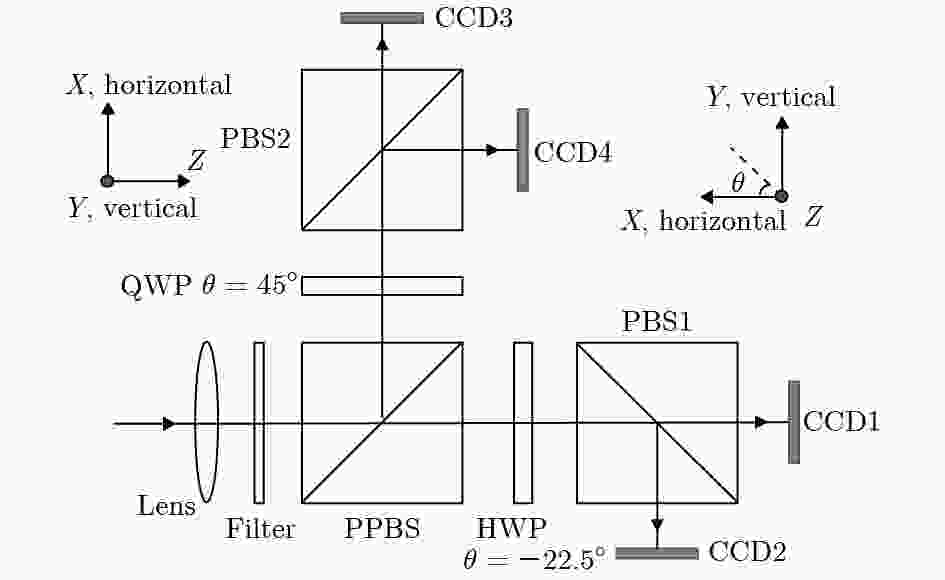
2019, 68 (2): 024203.
doi: 10.7498/aps.68.20181553
Abstract +
The division-of-amplitude full Stokes simultaneous polarization imaging system has prominent merits, such as real time, high spatial resolution, high precision, etc. The development of the division-of-amplitude full Stokes simultaneous polarization imaging system has a high application value. The division-of-amplitude full Stokes simultaneous polarization imaging system uses polarization beam splitters, a half wave plate (HWP) and a quarter wave plate (QWP) to modulate the incident Stokes vector into four intensity images. Using the four intensity images, the incident Stokes vector can be analyzed. In the system, the phase delay errors of the HWP and the QWP have a direct influence on the measurement accuracy of the incident Stokes vector. A Stokes vector measurement error equation containing the phase delay errors of the HWP and the QWP is established. When there are the phase delay errors of the HWP and the QWP in the system, the Stokes vector measurement errors of the unpolarized light, 0° liner polarized light, 90° liner polarized light, 45° liner polarized light, 135° liner polarized light, right circularly polarized light and left circularly polarized light are analyzed. A method of solving the Stokes vector measurement error of incident light with any polarization state is given. When the Stokes vectors with different degrees of polarization (DOPs) are used as the incident light, the simulation results show that both the Stokes vector measurement error and the DOP measurement error increase with the DOP of incident light increasing. Therefore, we select the polarization measurement accuracy to evaluate the system when the DOP of incident light equals 1. To ensure that the polarization measurement accuracy of the system is within 2%, the phase delay error of the HWP should be within ±1.6° and the phase delay error of the QWP should be within ±0.5°. The analysis results of the phase delay errors of the HWP and the QWP are of great significance for improving the polarization measurement accuracy of the division-of-amplitude full Stokes simultaneous polarization imaging system, and also provide important theoretical guidance in designing and developing the system.

2019, 68 (2): 024204.
doi: 10.7498/aps.68.20181602
Abstract +
The navigation mechanism of obtaining phase parameters based on quantum theory can break through the limitation of classical physical limit to navigation accuracy. In order to achieve the accurate estimation of the coherent state phase, it is usually assumed that the local oscillator phase must be orthogonal to the coherent state phase in the method of quantum homodyne detection. However, the coherent state phase is unknown and the hypothesis cannot be guaranteed to be correct in practice. In this paper we design a nonlinear phase-locked loop to solve the problem. Firstly, in order to obtain the Wigner distribution for a coherent state, we start with the Wigner distribution for the vacuum state and analyze the noise characteristics according to Wigner distribution of coherent state, then the output of homodyne detection is derived. Secondly, in order to avoid introducing errors in theory, caused by linearization and cope with the limiting requirement between local oscillator phase and coherent state phase in the phase tracking of coherent state, we design an orthogonal simplex cubature Kalman filter (OSCKF) algorithm to achieve the function of the nonlinear phase-locked loop. The algorithm converges by updating the state of the local oscillator phase multiple times, and then, the accurate coherent phase is obtained. Finally, according to the design of the phase-locked loop, we observe the data of homodyne detection and then verify the correctness of the OSCKF algorithm. The simulation results show that the OSCKF can converge to the real phase after observing 200 sampled data and the accuracy is higher than extended Kalmn filter (EKF) and cubature Kalman filter (CKF), and the real phase can be obtained under different local oscillator phase. In conclusion, the nonlinear phase-locked loop based on OSCKF algorithm breaks the limitation of traditional way in which the initial local oscillator phase is required to be orthogonal to the coherent state phase, and effectively avoid the linearization error and improve the anti-nonlinear ability. It is very significant in theory and application .

2019, 68 (2): 024301.
doi: 10.7498/aps.68.20181452
Abstract +
It can be a difficult problem to precisely predict the acoustic field radiated from a finite elastic structure in shallow water channel because of its strong coupling with up-down boundaries and the fluid medium, whose acoustic field cannot be calculated directly by existing methods, such as Ray theory, normal mode theory and other different methods, which are adaptable to sound fields from idealized point sources in waveguide. So, there is no reliable research method of predicting the acoustic radiation of elastic structure in shallow water at present. Based on the finite element method (FEM) coupled with the parabolic equation (PE), the theoretical model for structure acoustic radiation in shallow water at low frequency is established in this paper. This model mainly consists of three sections. First, obtaining the near-field vibro-acoustic characteristics of the elastic structure in shallow water by the multi-physics coupling model established by FEM, whose FEM model includes the up-down boundaries and the completely absorbent sound boundaries in the horizontal direction. Second, getting the acoustic information in the depth, which is set as the acoustic input condition i.e. starting field for the PE. Third, the acoustic information in the far-field quickly calculated by the PE and the finite difference method (FDM). The accuracy, efficiency and fast convergence of FEM-PE method are validated by numerical simulation and theoretical analysis through using a monopole source and structural source in the Pekeris waveguide, respectively. The vibro-acoustic characteristics of elastic cylinder influenced by upper and lower fluid boundaries of the Pekeris waveguide are calculated and analyzed. The cylindrical shell material is steel, and it is 1 m in radius and 10 m in length. The shallow water channel is a Pekeris waveguide with 30 m in depth, at the upper boundary, i.e., the free surface, the lower boundary is the semi-infinite liquid boundary. The analyzed frequencies range from 50 Hz to 200 Hz. The study shows that when the cylindrical shell approaches to the sea surface or bottom, the coupled frequency is higher or lower respectively than that of the shell immersed in the free field. When the diving depth reaches a certain distance range, the coupled frequency tends to be the same as that in free field. The acoustic field radiated from an elastic shell in Pekeris waveguide is similar to that from a point source at low frequency, but there exists a significant difference in high frequency between them, so the structural source can be equivalent to a point source conditionally. The sound radiation attenuation of the structure happens in sequence according to the near-field acoustic shadow zone, the spherical wave attenuation zone, the region between spherical wave and the cylindrical wave attenuation zone, and the cylindrical wave attenuation zone.

2019, 68 (2): 024302.
doi: 10.7498/aps.68.20181794
Abstract +
Vertical spatial characteristics of the wind-generated noise include the noise vertical directionality and the noise vertical coherence, which seriously affect the performance of sonar devices and play an important role in ocean environment parameters inversion. In this paper, we investigate the influence of surface duct on the noise vertical spatial characteristics at the depths below the duct. The Kuperman-Ingenito (K/I) model is employed to describe the distribution of the noise sources, and Pekeris-branch-cut-based normal modes are used to represent the Green's functions between the noise sources and the receivers. Both the noise vertical directionality and the noise vertical coherence are expressed as a function of the normal modes, so that we can investigate the physical reason for the variance of the noise vertical spatial characteristics by analyzing the variance of the normal modes. The numerical simulations on the noise vertical spatial characteristics show that the influence of surface duct above the critical depth is different from that below the critical depth. Above the critical depth, there exists a peak in the noise vertical directionality at the edge of the horizontal notch close to the bottom side. In the presence of surface duct, this peak significantly rises up, and the noise vertical coherence deviates from that in the absence of surface duct and tends to be perfect positive coherence and perfect negative coherence periodically as the vertical distance between the two receivers increases. On the other hand, below the critical depth, the noise power comes from the horizontal direction becomes stronger and the noise vertical coherence tends to be perfect positive coherence in the presence of surface duct as compared with the case in the absence of surface duct. Moreover, the influence will become severer as the thickness of the surface duct increases, while almost keep unchanged when the sound speed gradient in the surface duct varies. The modal analysis indicates that the noise source excites more refracted normal modes with stronger modal intensity in the presence of surface duct, and the excited refracted normal modes become more and stronger if the surface duct is thicker. As the result, the increase of the refracted mode number and the enhancement of their modal intensity cause the vertical spatial characteristics of noise to change.

2019, 68 (2): 024303.
doi: 10.7498/aps.68.20181955
Abstract +
Sandwich transducers are extremely versatile, but when the lateral dimension is too large, the displacement of the radiating surface is uneven due to the coupling vibration. Due to the unique vibrational band gap characteristics of phononic crystal, vibrations in the bandgap range can be prohibited from propagating for infinite periodic structure or suppressed for finite periodic structure, which makes it widely used in the field of vibration suppression. In this paper, a two-dimensional phononic crystal structure is formed by processing periodically aligned grooves in the front cover of a large-sized sandwich transducer. Since the periodic grooves are formed in the radial direction, the radial waves cannot propagate, and thus the lateral vibration is suppressed. Subsequently, the finite element method is used to simulate the vibration transmission characteristic, resonance frequency and emission voltage response of a large-sized sandwich transducer based on two-dimensional phononic crystal. The effects of slot height and slot width on its bandgap, resonance and anti-resonant frequency, bandwidth, and displacement profile of the radiating surface are discussed. The results show that the phonon crystal structure can be optimized by using a large-sized sandwich transducer. The large-sized sandwich transducer based on two-dimensional phononic crystal has a lateral band gap. When the operating frequency of the large-sized sandwich transducer is within the band gap range, the two-dimensional phononic crystal structure can effectively suppress the lateral vibration, and the uniformity of the displacement distribution of the radiating surface of the transducer is improved. In addition, when the slot width is constant, the bandwidth of the large-sized sandwich transducer based on the two-dimensional phononic crystal increases as the slot height increases. Similarly, when the slot height is constant, the bandwidth of the large-sized sandwich transducer based on the two-dimensional phononic crystal increases as the slot width increases. The two-dimensional phononic crystal structure is processed in the front cover of the large-sized sandwich transducer, and the working frequency band of the large-sized sandwich transducer is effectively broadened.
PHYSICS OF GASES, PLASMAS, AND ELECTRIC DISCHARGES
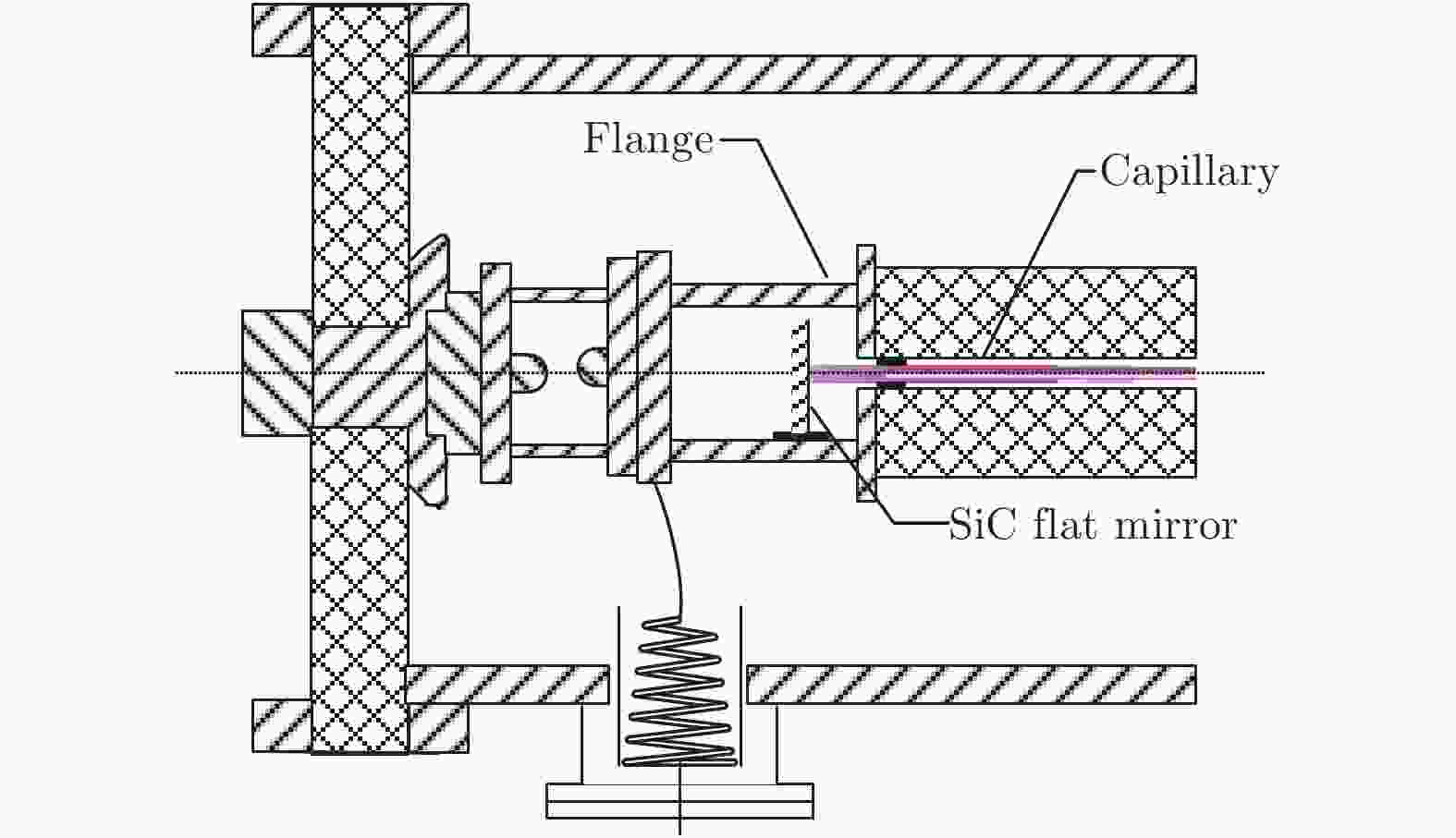
2019, 68 (2): 025201.
doi: 10.7498/aps.68.20181617
Abstract +
In this paper, a double-pass amplification experiment of a Ne-like Ar C line 69.8 nm laser is established. The 45-cmlong capillary is used as the discharge load to obtain a double-pass amplification output of a Ne-like Ar C line 69.8 nm laser. Under the same initial experimental conditions that the initial pressure is 15.4 Pa and the main pulse current amplitude is 13.5 kA, the laser pulse intensity and the full width at half maximum (FWHM) of the laser pulse of the single-pass amplification output and the double-pass amplification output are measured by a vacuum X-ray diode (XRD) behind a vacuum ultraviolet (VUV) monochromator (Acton VSN-515) which is used to disperse the extreme ultraviolet (EUV) emission. And then the laser beam divergence of single-pass amplification output and double-pass amplification output are also measured by a space-resolving flat-field EUV spectrograph combined with an EUV CCD (Andor Newton DO920P-BN). The amplitude of the double-pass amplification laser output is 9 times larger than that of single-pass amplification output, and the FWHM of the double-pass amplification laser pulse is nearly 2.4 ns. While the laser beam divergence angle of the double-pass amplification output is 6.6 times wider than that of single-pass amplification output. By comparing the single-pass amplification and double-pass amplification output experimental results, the gain duration of the gain medium in the double-pass amplification and the radial distribution characteristics of the gain medium are analyzed by using the calculation formula of the double-pass amplification laser intensity. The gain duration is more than 4 ns, during this time the gain coefficient decreases at 1.6 ns. And the gain coefficient is the smallest at 2.8 ns, meanwhile the intensity of the single-pass amplification laser is maximum, and the gain medium is in the gain saturation state. So this result indicates that the minimum gain coefficient at this moment is due to the gain saturation effect. Using a similar calculation method to analyze the spatial distribution of gain coefficients, the gain on the plasma axis is larger than that off the plasma axis. These results lay a foundation for the subsequent establishment of resonant cavity and the multi-pass amplification experiment of capillary discharge Ne-like Ar laser.
CONDENSED MATTER: STRUCTURAL, MECHANICAL, AND THERMAL PROPERTIES

2019, 68 (2): 026401.
doi: 10.7498/aps.68.20181315
Abstract +
The fractal is a kind of geometric figure with self-similar character. Phase transition and critical phenomenon of spin model on fractal lattice have been widely studied and many interesting results have been obtained. The ${S^4}$ model regarded as an extension of the Ising model, can take a continuous spin value. Research of the ${S^4}$ model can give a better understanding of the phase transition in the real ferromagnetic system in nature. In previous work, the phase transition of the ${S^4}$ model on the translation symmetry lattice has been studied with the momentum space renormalization group technique. It is found that the number of the fixed points is related to the space dimensionality. In this paper, we generate a family of diamond hierarchical lattices. The lattice is a typical inhomogenous fractal with self-similar character, whose fractal dimensionality and the order of ramification are ${d_{\rm{f}}} = {\rm{1}} + \ln m/\ln {\rm{3}}$ and $R = \infty $ , respectively. In order to discuss the phase transition of the ${S^4}$ model on the lattice, we assume that the Gaussian distribution constant ${b_i}$ and the fourth-order interaction parameter ${u_i}$ depend on the coordination number ${q_i}$ of the site on the fractal lattices, and the relation ${b_i}/{b_j} = {u_i}/{u_j} = {q_i}/{q_j}$ is satisfied. Using the renormalization group and the cumulative expansion method, we study the phase transition of the ${S^4}$ model on a family of diamond lattices of $m$ branches. Removing the inner sites, we obtain the system recursion relation and the system corresponding critical point. Furthermore, we find that if the number of branches is $m = 2$ or $m > {\rm{1}}2$ (fractal dimensionality${d_{\rm{f}}} = {\rm{1}}{\rm{.63}}$ or${d_{\rm{f}}} > {\rm{3}}{\rm{.26}}$ ), the system only has the Gaussian fixed point of ${K^ * } = {b_2}/2$ , $u_2^ * = 0$ . The critical point of the system is in agreement with that from the Gaussian model on the fractal lattice, which predicts that the two systems belong to the same university class. We also find that under the condition of ${\rm{3}} \leqslant m \leqslant {\rm{1}}2$ (fractal dimensionality${\rm{2}} \leqslant {d_{\rm f}} \leqslant {\rm{3}}{\rm{.26}}$ ), both the Gaussian fixed point and the Wilson-Fisher fixed point can be obtained in the system, and the Wilson-Fisher fixed point plays a leading role in the critical properties of the system. According to the real space renormalization group transformation and scaling theory, we obtain the critical exponent of the correlation length. Finally, we find that the critical points of the ${S^4}$ model on a family of diamond lattices depend on the value of the fractal dimensionality. The above result is similar to that obtained from the ${S^4}$ model on the translation symmetry lattice.
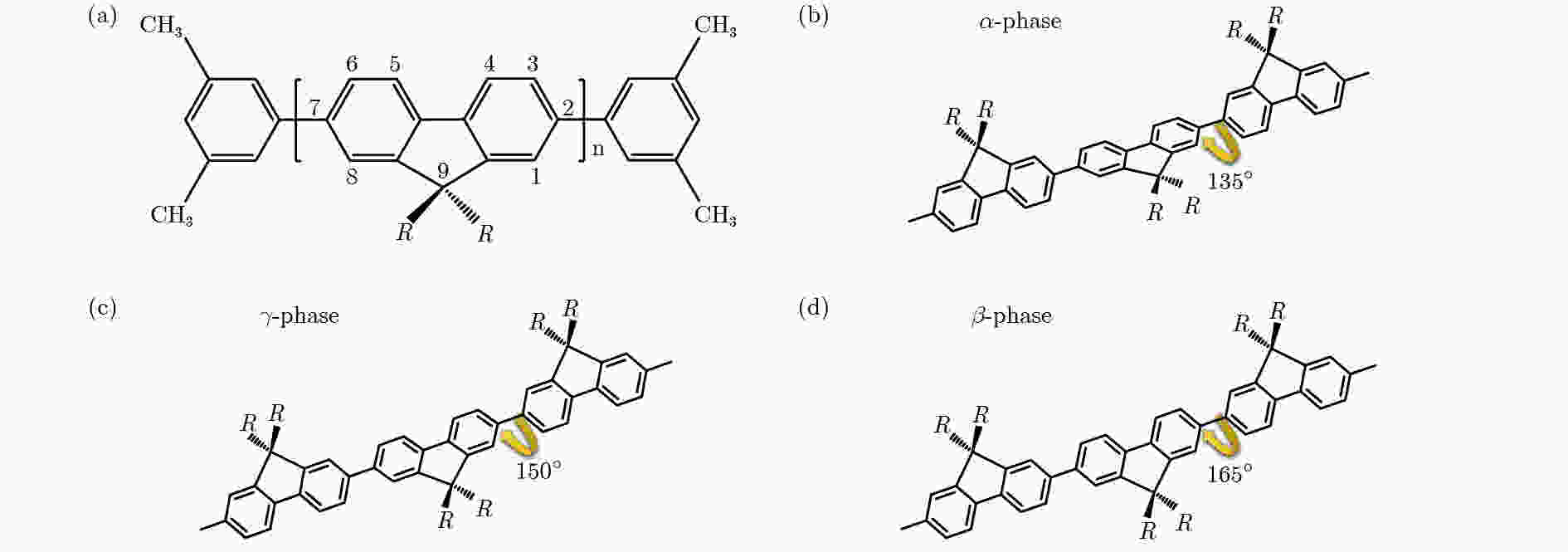
2019, 68 (2): 026402.
doi: 10.7498/aps.68.20182008
Abstract +
The conjugated polymer polyflourene has been well studied for its strong blue light emission ability and high quantum efficiency behavior. It has wide applications for light emitting diodes, sensors as well as photo-detectors. Therein the $ \beta $ conformation of PFO crystals is more attractive due to its longer conjugation length, higher carrier mobility and better luminous efficiency. Therefore it is great essential to control the formation and stability of $ \beta $ conformation of PFO crystals to develop new kind of photo-electronic devices. As is known, polymeric materials confined in a nanometer-sized space often exhibit unique properties compared with their bulk state, such as abnormal chain mobility, molecular assembly and phase transition behavior. These factors are of great significance to develop new kind of material and applications. Generally the confined condition includes quantum dot (zero-dimensional, 0D), nanowire or nanotube (1D), ultrathin film (2D) and nanoparticle (3D). In this paper, we design a unique 1D nanoconfined environment based on vertically aligned carbon nanotube (CNT) array structure. An ultra-high CNT density is achieved through a solvent-induced contraction process. The adjacent narrow carbon nanotube gap thus forms a quasi-1 confined nano-space with the tunable size ranging from 5 to 50 nm. Then we infiltrate the conjugated polymer poly(9,9-dioctylfluorene-2,7-diyl) (PFO) into those nano-gaps of carbon nanotube arrays through a solvent evaporation method to obtain the PFO infilled CNT array composite film. It is found that the chain mobility of PFO molecules in such a 1D nano-confined space of carbon nanotubes is significantly suppressed compared with the scenario of the spin-coated PFO film. The transition speed between different crystal forms of PFO declines greatly, which meanwhile improves the thermal stability of the $ \beta $ conformation of PFO crystal. Additionally, the aligned carbon nanotubes have great effects on the orientation and distribution of PFO chains. The PFO crystals are confirmed to grow preferentially along the longitudinal direction of CNT array, which is potential to grow PFO crystals with high quality and excellent performance. Thus, such a PFO/CNT array composite film can have great potential to prepare PFO photovoltaic devices with excellent luminescent properties and high stability in the future.

2019, 68 (2): 026701.
doi: 10.7498/aps.68.20181513
Abstract +
The metal-to-insulator transitions achieved in rare-earth nickelate (RNiO3) receive considerable attentions owning to their potential applications in areas such as temperature sensors, non-volatile memory devices, electronic switches, etc. In contrast to conventional semiconductors, the RNiO3 is a typical electron correlation system, in which the electronic band structure is dominant by the Coulomb energy relating to the d-band and its hybridized orbitals. It was previously pointed out that lattice distortion can largely influence the electronic band structures and further significantly affect the electronic transportation properties, such as the resistivity and metal-to-insulator transition properties. Apart from directly measuring the transportation performance, the variations in the origin of carrier conduction and orbital transitions relating to the strain distortion of RNiO3 can also be reflected via their optical properties. In this work, we investigate the optical properties of samarium nickel (SmNiO3) thin films when lattice distortions are induced by interfacial strains. To introduce the interfacial strain, the SmNiO3 thin films are epitaxially grown on the strontium titanate (SrTiO3) and lanthanum aluminate (LaAlO3) single crystal substrates by using the pulsed laser deposition. A bi-axial tensile distortion happens when the SmNiO3 thin films are grown on SrTiO3 due to the smaller lattice constant of SmNiO3 than that of SrTiO3, while the one grown on LaAlO3 is strain-relaxed. We measure the infrared radiation (IR) transmission spectra of the SmNiO3 thin films grown on various substrates. The obtained IR transmission spectra are fitted by a Drude-Lorentz model and further converted into the curves of photoconductivity versus IR frequency. Comparing the difference in photoconductance between low frequency and high frequency reflects the two different origins of the conduction, which are related to intraband transition and band-to-band transition, respectively. The smaller photoconductance is observed for SmNiO3/SrTiO3 than for SmNiO3/LaAlO3 at low frequency, and this is expected to be caused by the suppression of free carriers as reported previously for tensile distorted SmNiO3. The consistence is obtained when further measuring the electronic transportation such as temperature-dependent electrical resistivity, as a higher resistivity is observed for SmNiO3/SrTiO3 than for SmNiO3/LaAlO3. The combination of the investigation of electrical transport with that of infrared transmission indicates that the tensile distortion in structure stabilizes the insulating phase to eliminate a pronounced metal-to-insulator transition and elevates the transition temperature. This is related to the respective twisting of the NiO6 octahedron when tensile distortion regulates the valance state of the transition metal and further opens the band gap, which is further confirmed by results of the X-ray absorption spectrum.

2019, 68 (2): 026801.
doi: 10.7498/aps.68.20181530
Abstract +
In this paper, the stress distribution of Si/Ge interface and the mechanism of the point defect buffer layer in the stress release process of Si/Ge structure on a nanoscale are studied by the molecular dynamics method. The results show that in a one-dimensional interface model, the stress relaxation at the Si/Ge interface is closely related to the size of Ge of the simulation, and there is an approximately linear relationship between the decrease rate of interface stress and the size of Ge. The vacancy defect is introduced into the Ge film near the Si/Ge interface, and a point defect rich buffer layer forms, reducing the stress at the Si/Ge interface significantly. As the defect density in the buffer layer increases, the interface stress decreases step by step. Moreover, in the paper examined also is the mechanism by which the buffer layer affects the interface stress. The relationship between the stress variation caused by the point defect in the pure Ge structure and the defect density is compared and analyzed. The introduction of the defect buffer layer and the increase of the defect density can accelerate the release of the Si/Ge interface stress. The internal mechanism of the stress reduction would be that the defect introduces the compressive stress, which can offset the tensile stress generated by the lattice mismatch of the Si and Ge structure. Then the Si/Ge interface stress is reduced. Besides, as the defect density increases, the compressive stress introduced by the defect increases and the interface stress decreases. The examination shows that the introduction of the defect buffer layer into the growth of the pure Ge film on silicon can reduce the probability of the dislocation defect by structuring the buffer layer to reduce interface stress. And this method is indirectly confirmed by preliminary study of silicon-based Ge film growth with low-temperature buffer layer method.
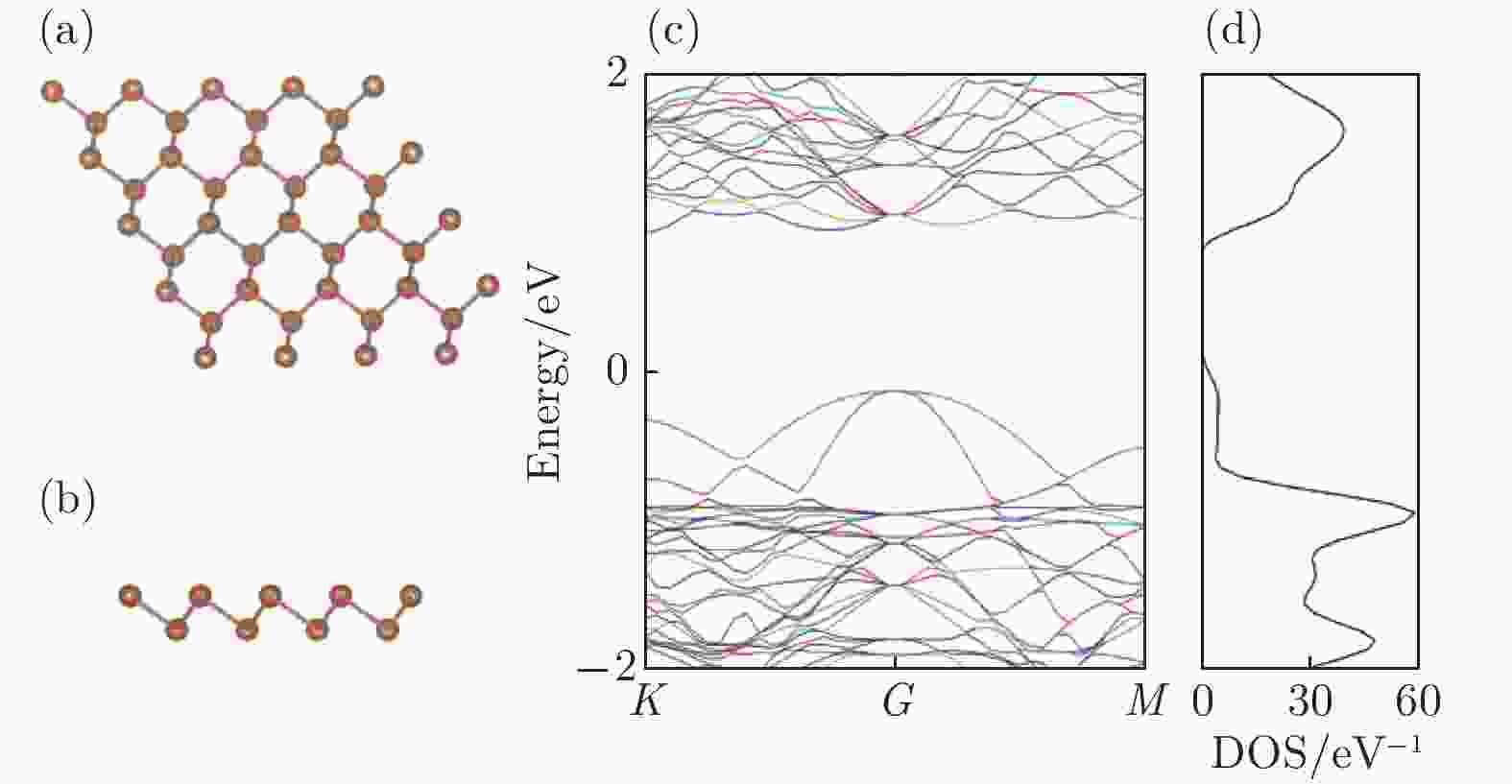
2019, 68 (2): 026802.
doi: 10.7498/aps.68.20181648
Abstract +
CONDENSED MATTER: ELECTRONIC STRUCTURE, ELECTRICAL, MAGNETIC, AND OPTICAL PROPERTIES
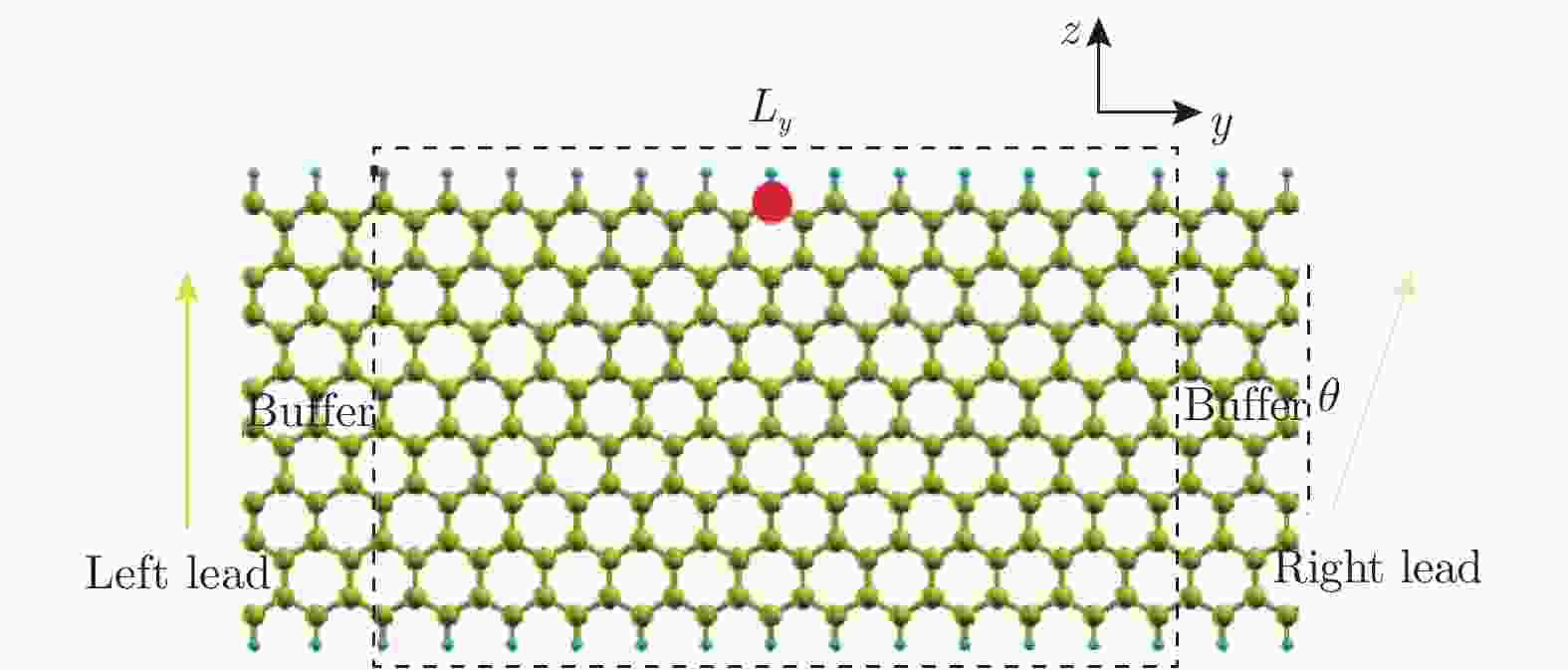
2019, 68 (2): 027101.
doi: 10.7498/aps.68.20181754
Abstract +
Zigzag graphene nanoribbon (ZGNR) is important for novel carbon-based spintronic applications. Currently, most of ZGNR spintronic studies focus on the collinear magnetism where the up-spin and down-spin are separated clearly. But in some cases, e.g. doping and adsorption, the magnetization profile can be modulated and thus noncollinear magnetism can occur. In order to shed light on possible noncollinear magnetism in ZGNR, we study non-collinear magnetism and electronic transport of boron or nitrogen-doped zigzag graphene nanoribbon based on noncollinear density functional theory and non-equilibrium Green's function method. For pristine ZGNR, our results show that the ZGNR presents helical magnetization distribution due to noncollinear magnetization in left and right lead. As the ZGNR is doped with boron and nitrogen atoms, the ZGNR shows a characteristic two-zone feature in the magnetization distribution. Near the dopant site, the magnetic moment of carbon atom is small. However, the magnetic moments of carbon atoms in the left (right) region of dopant are close to those of the left (right) lead. Such a feature provides the possibility of constructing domain walls with various widths on the edge of ZGNR. Moreover, the transmission at the Fermi level (E = 0 eV) decreases with the increase of relative angle between magnetizations of left and right lead, indicating that the spin-flip scattering dominates the electronic transport. However, at E = ±0.65 eV, there is a transmission dip with low transmission, which implies that the dopant induces the strong backscattering. To understand the origin of this dip, we calculate the density of states (DOS) and project the DOS onto each atom of doped ZGNR. The projected DOS shows a large and broad peak at E = −0.65 eV for N-doped ZGNR but at E = +0.65 eV for B-doped ZGNR. The consistency between the position of dip in transmission and the position of peak in DOS indicates that the transmission dip mentioned above is attributed to strong backscattering from the dopant-induced bound state. Our theoretical results are expected to be useful for understanding the noncollinear magnetism and spin scattering in the doped ZGNR-based devices. Also, our work provides a considerable insight into the design of ZGNR-based nanoelectronic devices, such as the transistor based on spin transfer torque effect.
INTERDISCIPLINARY PHYSICS AND RELATED AREAS OF SCIENCE AND TECHNOLOGY

2019, 68 (2): 028701.
doi: 10.7498/aps.68.20181891
Abstract +
Nanoparticles have been widely used in many fields such as nanomedicine and cell imaging. Understanding the microscopic mechanism of the interaction between nanoparticles and biomembranes is very vital for the synthesis and applications of nanoparticles. In this paper, using coarse-grained molecular dynamics simulation, we study the interaction between nanoparticles coated with fully or partially charged ligands and phase-separated biomembranes containing charged lipids. The results show that the final positions or states of nanoparticles on/in the biomembranes can be readily modulated by varying the grafting density, ratio, and type of charged ligands as well as the type of charged lipids. For the nanoparticle with a highly hydrophilic surface, the nanoparticle prefers to be adsorbed on the surface of the biomembrane. In this case, the electrostatic interaction determines that the nanoparticle is adsorbed on the surface of liquid-ordered domain or the surface of liquid-disordered domain. For the nanoparticle with a (partially) hydrophobic surface, the nanoparticle tends to penetrate into the lipid bilayer from the liquid-disordered domain. In this case, the hydrophobicity of the nanoparticle plays a crucial role in the penetrating of the nanoparticle. The hydrophilicity or hydrophobicity of the nanoparticle is affected by the ratio between the charged and neutral ligands, the grafting density of the charged ligands, and the ionic concentration in the system. Furthermore, the microscopic mechanism of the interaction between charged nanoparticles and charged biomembranes is revealed by using the potential of mean force between nanoparticles and lipid domains. The potential of mean force shows that none of the (partially) charged nanoparticles can spontaneously penetrate into the liquid-ordered domain due to a high free energy barrier but they can spontaneously penetrate into the liquid-disordered domain with a certain probability. However, due to the limitation of the simulation time and the number of sampling of the simulations, only some of the partially hydrophobic nanoparticles which are not initially adsorbed onto the surface of liquid-ordered domain are found to finally penetrate into the liquid-disordered domain in this work. This work yields some theoretical insights into the application of nanoparticles in nanomedicine, cell imaging, etc.




























